Design of HVAC System for Act 1 and Act 2 Towers in Dubai
VerifiedAdded on 2023/04/23
|29
|6847
|479
AI Summary
This document is about the comprehensive study of the design of a high rise building located in the United Arab Emirates. The project displays an ongoing real-life project in Dubai. The document includes abstract, introduction, literature survey, method, hourly analysis program (HAP), results, discussion, conclusion, and bibliography.
Contribute Materials
Your contribution can guide someone’s learning journey. Share your
documents today.
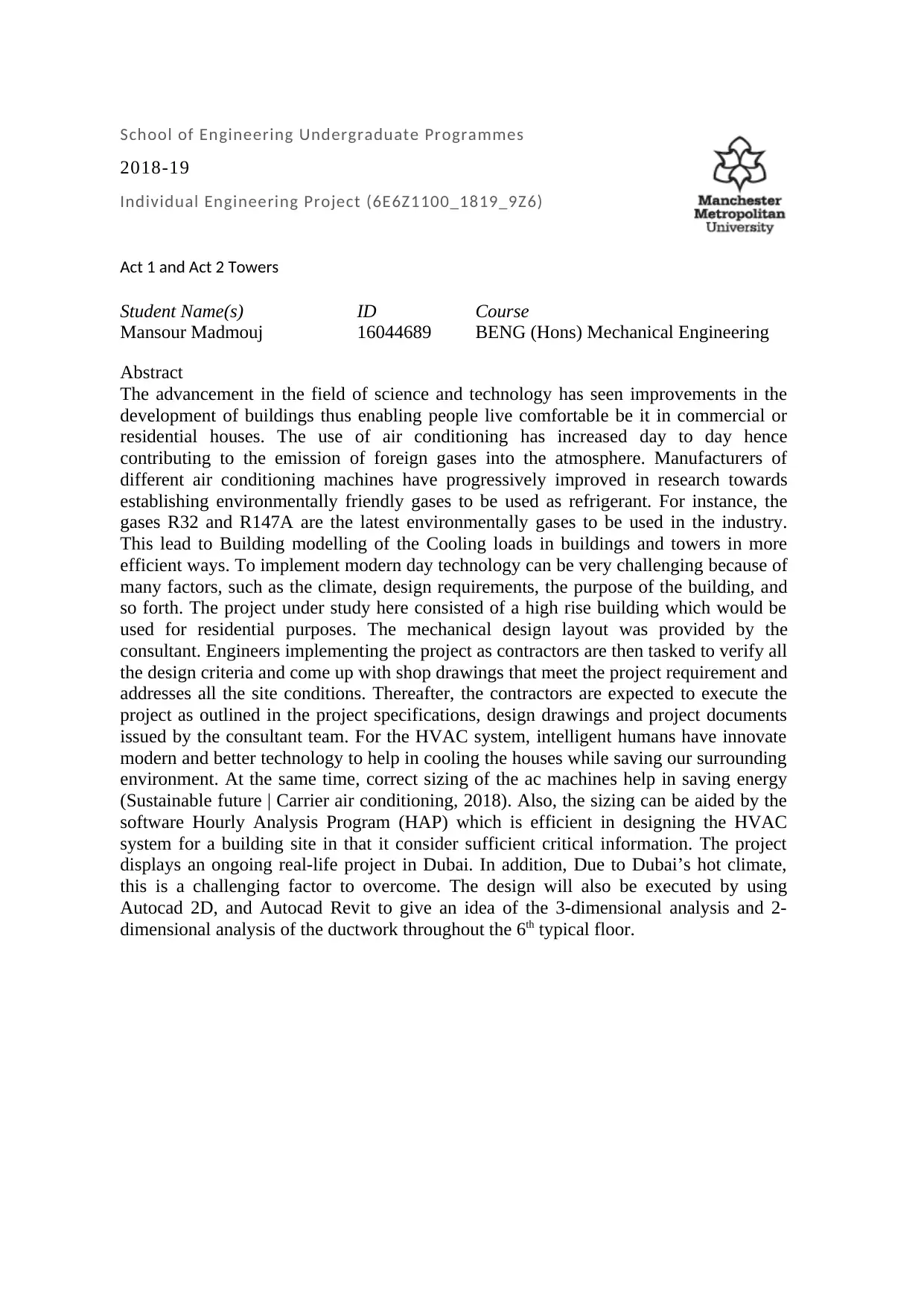
School of Engineering Undergraduate Programmes
2018-19
Individual Engineering Project (6E6Z1100_1819_9Z6)
Act 1 and Act 2 Towers
Student Name(s) ID Course
Mansour Madmouj 16044689 BENG (Hons) Mechanical Engineering
Abstract
The advancement in the field of science and technology has seen improvements in the
development of buildings thus enabling people live comfortable be it in commercial or
residential houses. The use of air conditioning has increased day to day hence
contributing to the emission of foreign gases into the atmosphere. Manufacturers of
different air conditioning machines have progressively improved in research towards
establishing environmentally friendly gases to be used as refrigerant. For instance, the
gases R32 and R147A are the latest environmentally gases to be used in the industry.
This lead to Building modelling of the Cooling loads in buildings and towers in more
efficient ways. To implement modern day technology can be very challenging because of
many factors, such as the climate, design requirements, the purpose of the building, and
so forth. The project under study here consisted of a high rise building which would be
used for residential purposes. The mechanical design layout was provided by the
consultant. Engineers implementing the project as contractors are then tasked to verify all
the design criteria and come up with shop drawings that meet the project requirement and
addresses all the site conditions. Thereafter, the contractors are expected to execute the
project as outlined in the project specifications, design drawings and project documents
issued by the consultant team. For the HVAC system, intelligent humans have innovate
modern and better technology to help in cooling the houses while saving our surrounding
environment. At the same time, correct sizing of the ac machines help in saving energy
(Sustainable future | Carrier air conditioning, 2018). Also, the sizing can be aided by the
software Hourly Analysis Program (HAP) which is efficient in designing the HVAC
system for a building site in that it consider sufficient critical information. The project
displays an ongoing real-life project in Dubai. In addition, Due to Dubai’s hot climate,
this is a challenging factor to overcome. The design will also be executed by using
Autocad 2D, and Autocad Revit to give an idea of the 3-dimensional analysis and 2-
dimensional analysis of the ductwork throughout the 6th typical floor.
2018-19
Individual Engineering Project (6E6Z1100_1819_9Z6)
Act 1 and Act 2 Towers
Student Name(s) ID Course
Mansour Madmouj 16044689 BENG (Hons) Mechanical Engineering
Abstract
The advancement in the field of science and technology has seen improvements in the
development of buildings thus enabling people live comfortable be it in commercial or
residential houses. The use of air conditioning has increased day to day hence
contributing to the emission of foreign gases into the atmosphere. Manufacturers of
different air conditioning machines have progressively improved in research towards
establishing environmentally friendly gases to be used as refrigerant. For instance, the
gases R32 and R147A are the latest environmentally gases to be used in the industry.
This lead to Building modelling of the Cooling loads in buildings and towers in more
efficient ways. To implement modern day technology can be very challenging because of
many factors, such as the climate, design requirements, the purpose of the building, and
so forth. The project under study here consisted of a high rise building which would be
used for residential purposes. The mechanical design layout was provided by the
consultant. Engineers implementing the project as contractors are then tasked to verify all
the design criteria and come up with shop drawings that meet the project requirement and
addresses all the site conditions. Thereafter, the contractors are expected to execute the
project as outlined in the project specifications, design drawings and project documents
issued by the consultant team. For the HVAC system, intelligent humans have innovate
modern and better technology to help in cooling the houses while saving our surrounding
environment. At the same time, correct sizing of the ac machines help in saving energy
(Sustainable future | Carrier air conditioning, 2018). Also, the sizing can be aided by the
software Hourly Analysis Program (HAP) which is efficient in designing the HVAC
system for a building site in that it consider sufficient critical information. The project
displays an ongoing real-life project in Dubai. In addition, Due to Dubai’s hot climate,
this is a challenging factor to overcome. The design will also be executed by using
Autocad 2D, and Autocad Revit to give an idea of the 3-dimensional analysis and 2-
dimensional analysis of the ductwork throughout the 6th typical floor.
Secure Best Marks with AI Grader
Need help grading? Try our AI Grader for instant feedback on your assignments.

Act 1 and Act 2 Towers
Individual Engineering Project (6E6Z1100_1819_9Z6)
Contents
Abstract.................................................................................................................................................1
Introduction...........................................................................................................................................2
Literature Survey...................................................................................................................................3
Method..................................................................................................................................................4
Hourly Analysis Program (HAP)......................................................................................................6
Results.................................................................................................................................................11
Manual Calculations....................................................................................................................11
Hourly Analysis Program (HAP):........................................................................................................20
Discussion...........................................................................................................................................22
Conclusion..........................................................................................................................................25
Bibliography......................................................................................................................................27
School of Engineering Undergraduate Programmes
Page 1
Individual Engineering Project (6E6Z1100_1819_9Z6)
Contents
Abstract.................................................................................................................................................1
Introduction...........................................................................................................................................2
Literature Survey...................................................................................................................................3
Method..................................................................................................................................................4
Hourly Analysis Program (HAP)......................................................................................................6
Results.................................................................................................................................................11
Manual Calculations....................................................................................................................11
Hourly Analysis Program (HAP):........................................................................................................20
Discussion...........................................................................................................................................22
Conclusion..........................................................................................................................................25
Bibliography......................................................................................................................................27
School of Engineering Undergraduate Programmes
Page 1

Act 1 and Act 2 Towers
Individual Engineering Project (6E6Z1100_1819_9Z6)
Introduction
As the summer heat in GCC can push the temperature to reach the 40s, the HVAC system is
not so much a luxury but a necessity in the building systems. The importance of such major
energy-consuming element has pushed researchers, scientists & field experts to incorporate
huge development regarding system components, mechanism, & even building architecture.
A typical centralised HVAC system consists of two major sections. The first section is the in-
building and the second is the outer section of the building. Furthermore, the system can be
broken down into five loops; indoor air loops, refrigerant loops, chilled water loops, free air
loops and condensate water loops. These loops are the building block of a comfortable
atmosphere within a building. These integral parts of the in-building loops have primary
components; terminal units, cooling coils, dampers, fans, ducts, and system controls. Also,
the chilled water loop consists of cooling coils, chiller evaporators, pumps, pipes, valves, and
system controls (2006 ASHRAE handbook, 2006). The most challenging segment in
designing a compatible HVAC system is the energy consumption as the in-door section
consists of the substantial amount of parts. This significant portion leads to high energy
consumption. Therefore, building energy-efficient system is the major part of Engineers’
mission. In this project, a comprehensive study of the design of a high rise building located in
the United Arab Emirates. The summers are hot and humid with day temperature at 42°C and
29.7 °C at night. Most days are sunny and clear, and winters are short and slightly warm.
During winter, day temperature is 23 °C and lows of 14 °C at night.
Moreover, the precipitation level has increased over the past decade with accumulated rain
intensity reaching 87.3 mm per year. In addition to the extremely hot weather, it is also
known of high humidity level that peaks to 65 (Mediaoffice.ae, 2018). Building a luxurious
tower in one of the most expensive communities in UAE; Downtown Dubai’s District at
Emaar Boulevard is an actual challenge. The tower is located near to the tallest skyscraper in
the World; Burj Khalifa. It is elegantly designed with 71 residential floors. The tower
includes four basements, Ground floor, Podium, six townhouses, amenity floor, 52 storeys
residential floors, two penthouses and seven technical floors. The total project area is 6700
m2 with a total built-up area of 93,000 m2. The residential area is almost 55,000 m2. However,
the tower also consists of mechanical floors that contain the in-door HVAC system.
Basement 3, third floor, eighteenth/Nineteenth floor, the forty-three/ forty-four floor, and the
sixty-eighth floor.
The cooling system applied will be provided through a central cooling plant which is a
governmental district cooling plant. Preceding a successful work in designing an HVAC
system, multiple factors are considered. Weather and Climate change is a core structure that
engineers reflect on. Heat gain in a building can happen because of solar energy coming
through the windows, or it could be due to internal devices, for example, lightning, electrical
equipment’s and people’s body heat (Sauer, Howell and Coad 2010 p. 45). The tower will
undergo a complex system of Air conditioning that will be chilled water that passes through
cooling coils in heat exchangers. The HVAC chilled water system works by supplying water
School of Engineering Undergraduate Programmes
Page 2
Individual Engineering Project (6E6Z1100_1819_9Z6)
Introduction
As the summer heat in GCC can push the temperature to reach the 40s, the HVAC system is
not so much a luxury but a necessity in the building systems. The importance of such major
energy-consuming element has pushed researchers, scientists & field experts to incorporate
huge development regarding system components, mechanism, & even building architecture.
A typical centralised HVAC system consists of two major sections. The first section is the in-
building and the second is the outer section of the building. Furthermore, the system can be
broken down into five loops; indoor air loops, refrigerant loops, chilled water loops, free air
loops and condensate water loops. These loops are the building block of a comfortable
atmosphere within a building. These integral parts of the in-building loops have primary
components; terminal units, cooling coils, dampers, fans, ducts, and system controls. Also,
the chilled water loop consists of cooling coils, chiller evaporators, pumps, pipes, valves, and
system controls (2006 ASHRAE handbook, 2006). The most challenging segment in
designing a compatible HVAC system is the energy consumption as the in-door section
consists of the substantial amount of parts. This significant portion leads to high energy
consumption. Therefore, building energy-efficient system is the major part of Engineers’
mission. In this project, a comprehensive study of the design of a high rise building located in
the United Arab Emirates. The summers are hot and humid with day temperature at 42°C and
29.7 °C at night. Most days are sunny and clear, and winters are short and slightly warm.
During winter, day temperature is 23 °C and lows of 14 °C at night.
Moreover, the precipitation level has increased over the past decade with accumulated rain
intensity reaching 87.3 mm per year. In addition to the extremely hot weather, it is also
known of high humidity level that peaks to 65 (Mediaoffice.ae, 2018). Building a luxurious
tower in one of the most expensive communities in UAE; Downtown Dubai’s District at
Emaar Boulevard is an actual challenge. The tower is located near to the tallest skyscraper in
the World; Burj Khalifa. It is elegantly designed with 71 residential floors. The tower
includes four basements, Ground floor, Podium, six townhouses, amenity floor, 52 storeys
residential floors, two penthouses and seven technical floors. The total project area is 6700
m2 with a total built-up area of 93,000 m2. The residential area is almost 55,000 m2. However,
the tower also consists of mechanical floors that contain the in-door HVAC system.
Basement 3, third floor, eighteenth/Nineteenth floor, the forty-three/ forty-four floor, and the
sixty-eighth floor.
The cooling system applied will be provided through a central cooling plant which is a
governmental district cooling plant. Preceding a successful work in designing an HVAC
system, multiple factors are considered. Weather and Climate change is a core structure that
engineers reflect on. Heat gain in a building can happen because of solar energy coming
through the windows, or it could be due to internal devices, for example, lightning, electrical
equipment’s and people’s body heat (Sauer, Howell and Coad 2010 p. 45). The tower will
undergo a complex system of Air conditioning that will be chilled water that passes through
cooling coils in heat exchangers. The HVAC chilled water system works by supplying water
School of Engineering Undergraduate Programmes
Page 2

Act 1 and Act 2 Towers
Individual Engineering Project (6E6Z1100_1819_9Z6)
to a primary heat exchanger that is installed on the side of the water pumps. For example, five
heat exchangers plate type would be working on duty to exchange the cooling energy to the
building side, the temperature difference on the secondary side will be 16°C, and the third
stage is two heat exchangers based on the mechanical floor at Level 43 and 44 to serve the
typical tower floors from Level 45 until Level 70, the temperature difference will be 16°C on
the primary side (5.5°C to 14.4°C). The cold water runs into the fan coil units. In return, the
hot water that will be recirculated can be used by another utility for heating purposes (Rezaie
and Rosen 2012 p. 36]. The energy consumption of the complex system is usually high
because it serves multiple zones in each area, and due to the extremely hot weather much
more cooling load is required to reach a comfortable atmosphere. One of the main design
factors that will be focused on is the size of the equipment. Therefore, for a large multiple-
zone VAV system the fan energy use will be gigantically high if an undersized fan is
equipped. Ventilation is also part of the design; it is broken down into two paths. The first
path is the mechanical ventilation that uses fans to recirculate air inside the building to the
outside. The requirements of minimum air ventilation are in ASHRAE Standard 62.1 [2006
ASHRAE handbook, 2006]. The second part of ventilation is the natural type that does not
need any equipment. However, it is done by specifically designing airflow ventilation paths
using a pressurised air system. In other words, it is called the air changes per hour (ACPH).
Equation (X)
Where:
ACPH - number of air changes/hour.
Vol - volume of the space l ×w × h in meters cubic.
Q - volumetric flow rate in cubic meters/minute.
Air distribution arrangements in each area aim to reach a pressure equilibrium. The capacity
of air leaving and entering the space must be the equal (Bearg 2013 p. 23). Moreover, air
change rates are dependent on the design of the commercial building, for example, residential
area ventilation rates are calculated based on the parameters of the architectural plan and the
number of the occupants. On the other hand, non-occupational areas like parking basement
standards require larger amounts of air change rates because of air contaminant due to
exhaust gases [2006 ASHRAE handbook, 2006]. Also, the heat energy recovery ventilation is
utilised by using the latent heat absorption from the exhaust gasses. This supports energy
efficiency in Ventilation energy recovery.
Literature Survey
The process of providing a comfortable environment for occupants in a given space,
commercial or domestic, is done by Air conditioning. Air conditioning is needed because it is
resposible for the removable of moist and heat from an occupied space. This process can also
School of Engineering Undergraduate Programmes
Page 3
Individual Engineering Project (6E6Z1100_1819_9Z6)
to a primary heat exchanger that is installed on the side of the water pumps. For example, five
heat exchangers plate type would be working on duty to exchange the cooling energy to the
building side, the temperature difference on the secondary side will be 16°C, and the third
stage is two heat exchangers based on the mechanical floor at Level 43 and 44 to serve the
typical tower floors from Level 45 until Level 70, the temperature difference will be 16°C on
the primary side (5.5°C to 14.4°C). The cold water runs into the fan coil units. In return, the
hot water that will be recirculated can be used by another utility for heating purposes (Rezaie
and Rosen 2012 p. 36]. The energy consumption of the complex system is usually high
because it serves multiple zones in each area, and due to the extremely hot weather much
more cooling load is required to reach a comfortable atmosphere. One of the main design
factors that will be focused on is the size of the equipment. Therefore, for a large multiple-
zone VAV system the fan energy use will be gigantically high if an undersized fan is
equipped. Ventilation is also part of the design; it is broken down into two paths. The first
path is the mechanical ventilation that uses fans to recirculate air inside the building to the
outside. The requirements of minimum air ventilation are in ASHRAE Standard 62.1 [2006
ASHRAE handbook, 2006]. The second part of ventilation is the natural type that does not
need any equipment. However, it is done by specifically designing airflow ventilation paths
using a pressurised air system. In other words, it is called the air changes per hour (ACPH).
Equation (X)
Where:
ACPH - number of air changes/hour.
Vol - volume of the space l ×w × h in meters cubic.
Q - volumetric flow rate in cubic meters/minute.
Air distribution arrangements in each area aim to reach a pressure equilibrium. The capacity
of air leaving and entering the space must be the equal (Bearg 2013 p. 23). Moreover, air
change rates are dependent on the design of the commercial building, for example, residential
area ventilation rates are calculated based on the parameters of the architectural plan and the
number of the occupants. On the other hand, non-occupational areas like parking basement
standards require larger amounts of air change rates because of air contaminant due to
exhaust gases [2006 ASHRAE handbook, 2006]. Also, the heat energy recovery ventilation is
utilised by using the latent heat absorption from the exhaust gasses. This supports energy
efficiency in Ventilation energy recovery.
Literature Survey
The process of providing a comfortable environment for occupants in a given space,
commercial or domestic, is done by Air conditioning. Air conditioning is needed because it is
resposible for the removable of moist and heat from an occupied space. This process can also
School of Engineering Undergraduate Programmes
Page 3
Secure Best Marks with AI Grader
Need help grading? Try our AI Grader for instant feedback on your assignments.
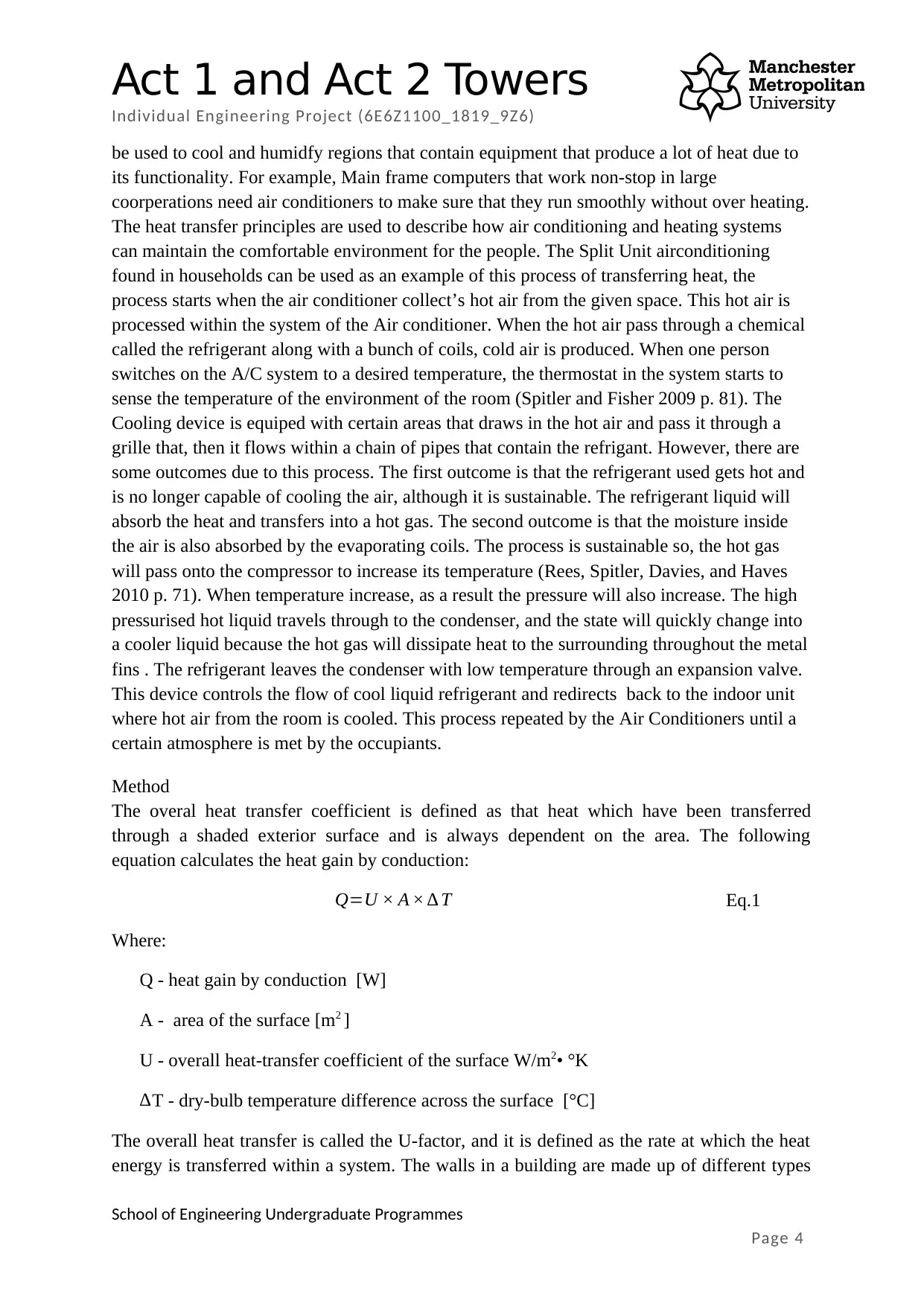
Act 1 and Act 2 Towers
Individual Engineering Project (6E6Z1100_1819_9Z6)
be used to cool and humidfy regions that contain equipment that produce a lot of heat due to
its functionality. For example, Main frame computers that work non-stop in large
coorperations need air conditioners to make sure that they run smoothly without over heating.
The heat transfer principles are used to describe how air conditioning and heating systems
can maintain the comfortable environment for the people. The Split Unit airconditioning
found in households can be used as an example of this process of transferring heat, the
process starts when the air conditioner collect’s hot air from the given space. This hot air is
processed within the system of the Air conditioner. When the hot air pass through a chemical
called the refrigerant along with a bunch of coils, cold air is produced. When one person
switches on the A/C system to a desired temperature, the thermostat in the system starts to
sense the temperature of the environment of the room (Spitler and Fisher 2009 p. 81). The
Cooling device is equiped with certain areas that draws in the hot air and pass it through a
grille that, then it flows within a chain of pipes that contain the refrigant. However, there are
some outcomes due to this process. The first outcome is that the refrigerant used gets hot and
is no longer capable of cooling the air, although it is sustainable. The refrigerant liquid will
absorb the heat and transfers into a hot gas. The second outcome is that the moisture inside
the air is also absorbed by the evaporating coils. The process is sustainable so, the hot gas
will pass onto the compressor to increase its temperature (Rees, Spitler, Davies, and Haves
2010 p. 71). When temperature increase, as a result the pressure will also increase. The high
pressurised hot liquid travels through to the condenser, and the state will quickly change into
a cooler liquid because the hot gas will dissipate heat to the surrounding throughout the metal
fins . The refrigerant leaves the condenser with low temperature through an expansion valve.
This device controls the flow of cool liquid refrigerant and redirects back to the indoor unit
where hot air from the room is cooled. This process repeated by the Air Conditioners until a
certain atmosphere is met by the occupiants.
Method
The overal heat transfer coefficient is defined as that heat which have been transferred
through a shaded exterior surface and is always dependent on the area. The following
equation calculates the heat gain by conduction:
Q=U × A × ∆ T Eq.1
Where:
Q - heat gain by conduction [W]
A - area of the surface [m2 ]
U - overall heat-transfer coefficient of the surface W/m2• °K
∆T - dry-bulb temperature difference across the surface [°C]
The overall heat transfer is called the U-factor, and it is defined as the rate at which the heat
energy is transferred within a system. The walls in a building are made up of different types
School of Engineering Undergraduate Programmes
Page 4
Individual Engineering Project (6E6Z1100_1819_9Z6)
be used to cool and humidfy regions that contain equipment that produce a lot of heat due to
its functionality. For example, Main frame computers that work non-stop in large
coorperations need air conditioners to make sure that they run smoothly without over heating.
The heat transfer principles are used to describe how air conditioning and heating systems
can maintain the comfortable environment for the people. The Split Unit airconditioning
found in households can be used as an example of this process of transferring heat, the
process starts when the air conditioner collect’s hot air from the given space. This hot air is
processed within the system of the Air conditioner. When the hot air pass through a chemical
called the refrigerant along with a bunch of coils, cold air is produced. When one person
switches on the A/C system to a desired temperature, the thermostat in the system starts to
sense the temperature of the environment of the room (Spitler and Fisher 2009 p. 81). The
Cooling device is equiped with certain areas that draws in the hot air and pass it through a
grille that, then it flows within a chain of pipes that contain the refrigant. However, there are
some outcomes due to this process. The first outcome is that the refrigerant used gets hot and
is no longer capable of cooling the air, although it is sustainable. The refrigerant liquid will
absorb the heat and transfers into a hot gas. The second outcome is that the moisture inside
the air is also absorbed by the evaporating coils. The process is sustainable so, the hot gas
will pass onto the compressor to increase its temperature (Rees, Spitler, Davies, and Haves
2010 p. 71). When temperature increase, as a result the pressure will also increase. The high
pressurised hot liquid travels through to the condenser, and the state will quickly change into
a cooler liquid because the hot gas will dissipate heat to the surrounding throughout the metal
fins . The refrigerant leaves the condenser with low temperature through an expansion valve.
This device controls the flow of cool liquid refrigerant and redirects back to the indoor unit
where hot air from the room is cooled. This process repeated by the Air Conditioners until a
certain atmosphere is met by the occupiants.
Method
The overal heat transfer coefficient is defined as that heat which have been transferred
through a shaded exterior surface and is always dependent on the area. The following
equation calculates the heat gain by conduction:
Q=U × A × ∆ T Eq.1
Where:
Q - heat gain by conduction [W]
A - area of the surface [m2 ]
U - overall heat-transfer coefficient of the surface W/m2• °K
∆T - dry-bulb temperature difference across the surface [°C]
The overall heat transfer is called the U-factor, and it is defined as the rate at which the heat
energy is transferred within a system. The walls in a building are made up of different types
School of Engineering Undergraduate Programmes
Page 4
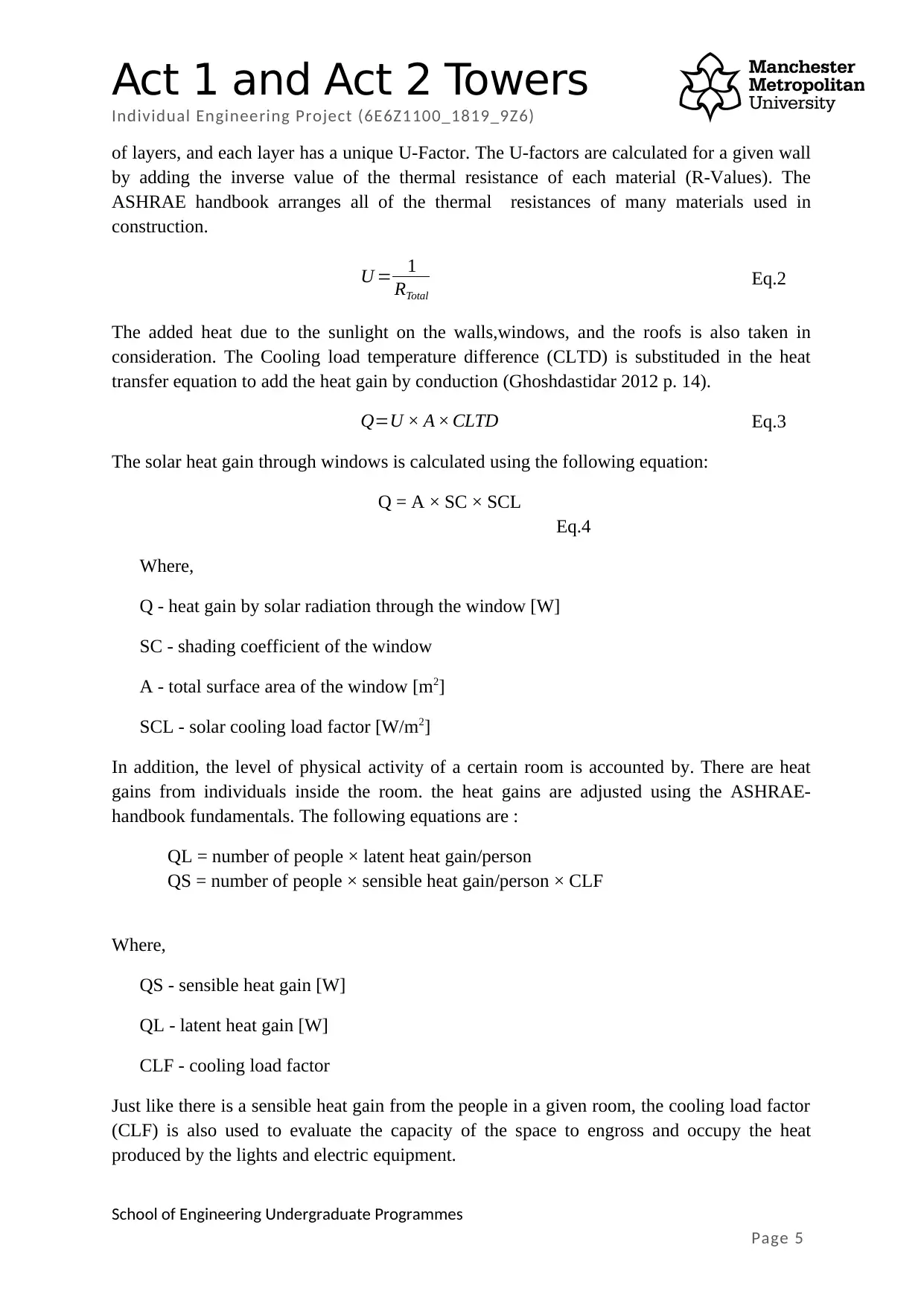
Act 1 and Act 2 Towers
Individual Engineering Project (6E6Z1100_1819_9Z6)
of layers, and each layer has a unique U-Factor. The U-factors are calculated for a given wall
by adding the inverse value of the thermal resistance of each material (R-Values). The
ASHRAE handbook arranges all of the thermal resistances of many materials used in
construction.
U = 1
RTotal
Eq.2
The added heat due to the sunlight on the walls,windows, and the roofs is also taken in
consideration. The Cooling load temperature difference (CLTD) is substituded in the heat
transfer equation to add the heat gain by conduction (Ghoshdastidar 2012 p. 14).
Q=U × A × CLTD Eq.3
The solar heat gain through windows is calculated using the following equation:
Q = A × SC × SCL
Eq.4
Where,
Q - heat gain by solar radiation through the window [W]
SC - shading coefficient of the window
A - total surface area of the window [m2]
SCL - solar cooling load factor [W/m2]
In addition, the level of physical activity of a certain room is accounted by. There are heat
gains from individuals inside the room. the heat gains are adjusted using the ASHRAE-
handbook fundamentals. The following equations are :
QL = number of people × latent heat gain/person
QS = number of people × sensible heat gain/person × CLF
Where,
QS - sensible heat gain [W]
QL - latent heat gain [W]
CLF - cooling load factor
Just like there is a sensible heat gain from the people in a given room, the cooling load factor
(CLF) is also used to evaluate the capacity of the space to engross and occupy the heat
produced by the lights and electric equipment.
School of Engineering Undergraduate Programmes
Page 5
Individual Engineering Project (6E6Z1100_1819_9Z6)
of layers, and each layer has a unique U-Factor. The U-factors are calculated for a given wall
by adding the inverse value of the thermal resistance of each material (R-Values). The
ASHRAE handbook arranges all of the thermal resistances of many materials used in
construction.
U = 1
RTotal
Eq.2
The added heat due to the sunlight on the walls,windows, and the roofs is also taken in
consideration. The Cooling load temperature difference (CLTD) is substituded in the heat
transfer equation to add the heat gain by conduction (Ghoshdastidar 2012 p. 14).
Q=U × A × CLTD Eq.3
The solar heat gain through windows is calculated using the following equation:
Q = A × SC × SCL
Eq.4
Where,
Q - heat gain by solar radiation through the window [W]
SC - shading coefficient of the window
A - total surface area of the window [m2]
SCL - solar cooling load factor [W/m2]
In addition, the level of physical activity of a certain room is accounted by. There are heat
gains from individuals inside the room. the heat gains are adjusted using the ASHRAE-
handbook fundamentals. The following equations are :
QL = number of people × latent heat gain/person
QS = number of people × sensible heat gain/person × CLF
Where,
QS - sensible heat gain [W]
QL - latent heat gain [W]
CLF - cooling load factor
Just like there is a sensible heat gain from the people in a given room, the cooling load factor
(CLF) is also used to evaluate the capacity of the space to engross and occupy the heat
produced by the lights and electric equipment.
School of Engineering Undergraduate Programmes
Page 5
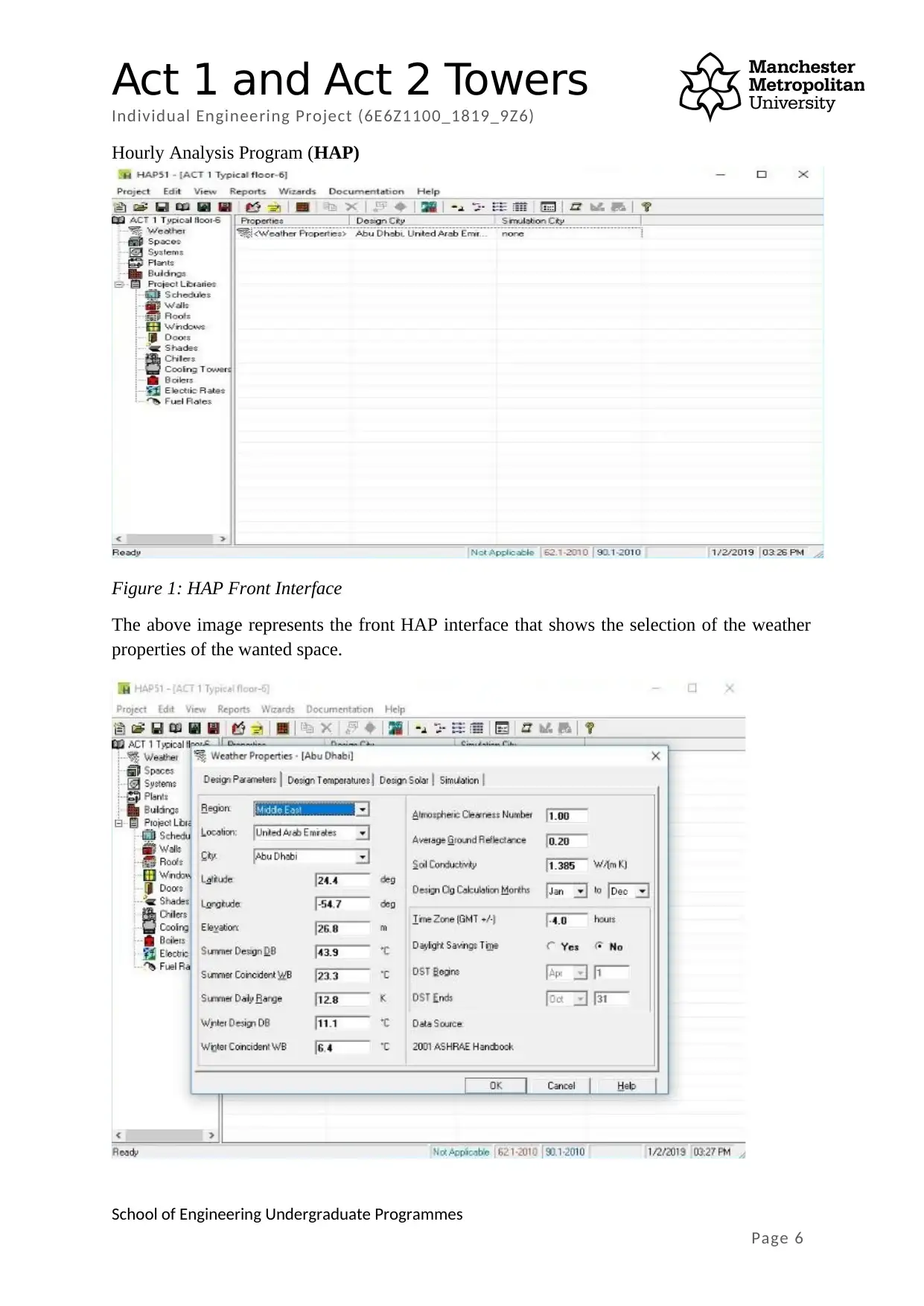
Act 1 and Act 2 Towers
Individual Engineering Project (6E6Z1100_1819_9Z6)
Hourly Analysis Program (HAP)
Figure 1: HAP Front Interface
The above image represents the front HAP interface that shows the selection of the weather
properties of the wanted space.
School of Engineering Undergraduate Programmes
Page 6
Individual Engineering Project (6E6Z1100_1819_9Z6)
Hourly Analysis Program (HAP)
Figure 1: HAP Front Interface
The above image represents the front HAP interface that shows the selection of the weather
properties of the wanted space.
School of Engineering Undergraduate Programmes
Page 6
Paraphrase This Document
Need a fresh take? Get an instant paraphrase of this document with our AI Paraphraser
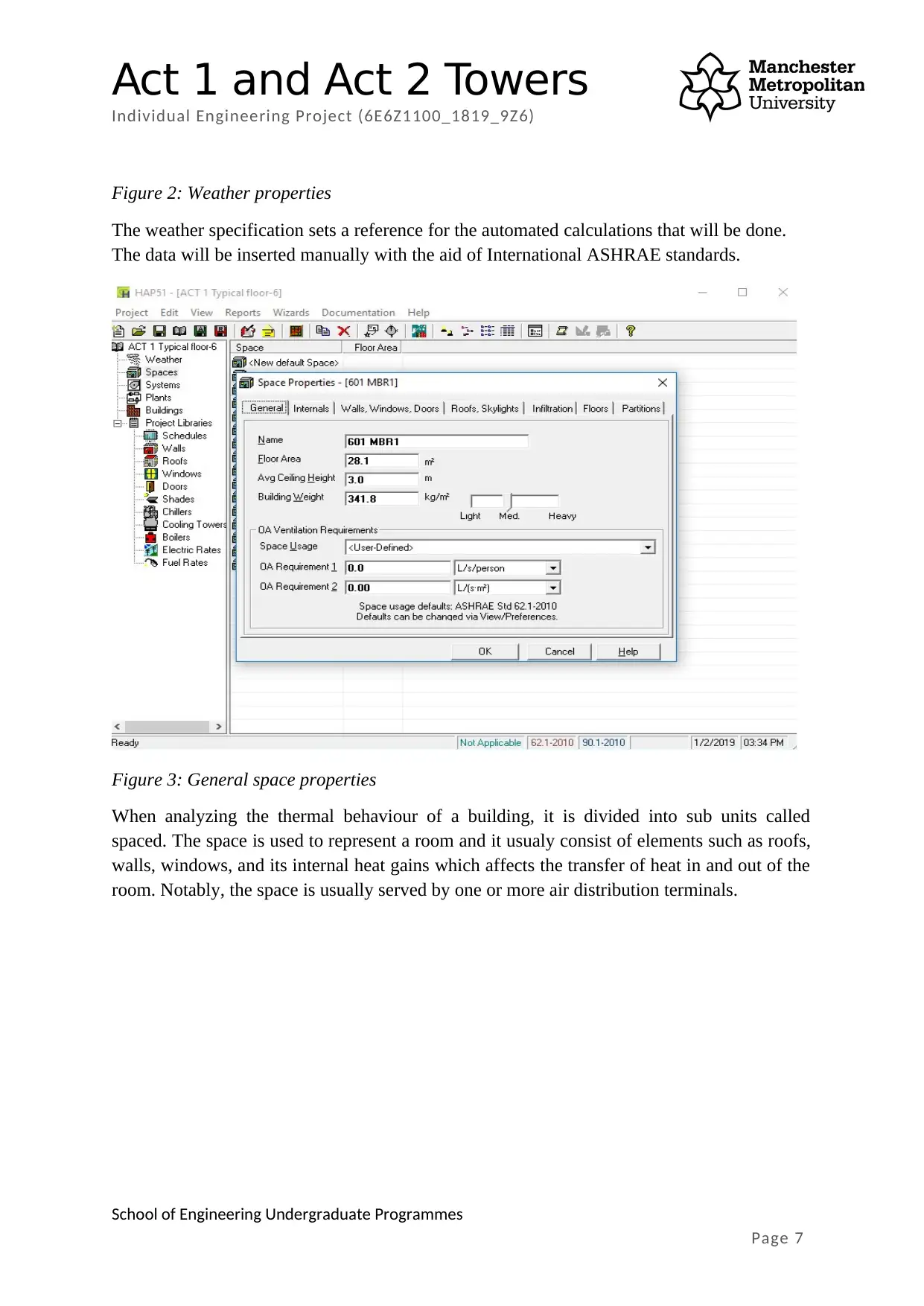
Act 1 and Act 2 Towers
Individual Engineering Project (6E6Z1100_1819_9Z6)
Figure 2: Weather properties
The weather specification sets a reference for the automated calculations that will be done.
The data will be inserted manually with the aid of International ASHRAE standards.
Figure 3: General space properties
When analyzing the thermal behaviour of a building, it is divided into sub units called
spaced. The space is used to represent a room and it usualy consist of elements such as roofs,
walls, windows, and its internal heat gains which affects the transfer of heat in and out of the
room. Notably, the space is usually served by one or more air distribution terminals.
School of Engineering Undergraduate Programmes
Page 7
Individual Engineering Project (6E6Z1100_1819_9Z6)
Figure 2: Weather properties
The weather specification sets a reference for the automated calculations that will be done.
The data will be inserted manually with the aid of International ASHRAE standards.
Figure 3: General space properties
When analyzing the thermal behaviour of a building, it is divided into sub units called
spaced. The space is used to represent a room and it usualy consist of elements such as roofs,
walls, windows, and its internal heat gains which affects the transfer of heat in and out of the
room. Notably, the space is usually served by one or more air distribution terminals.
School of Engineering Undergraduate Programmes
Page 7
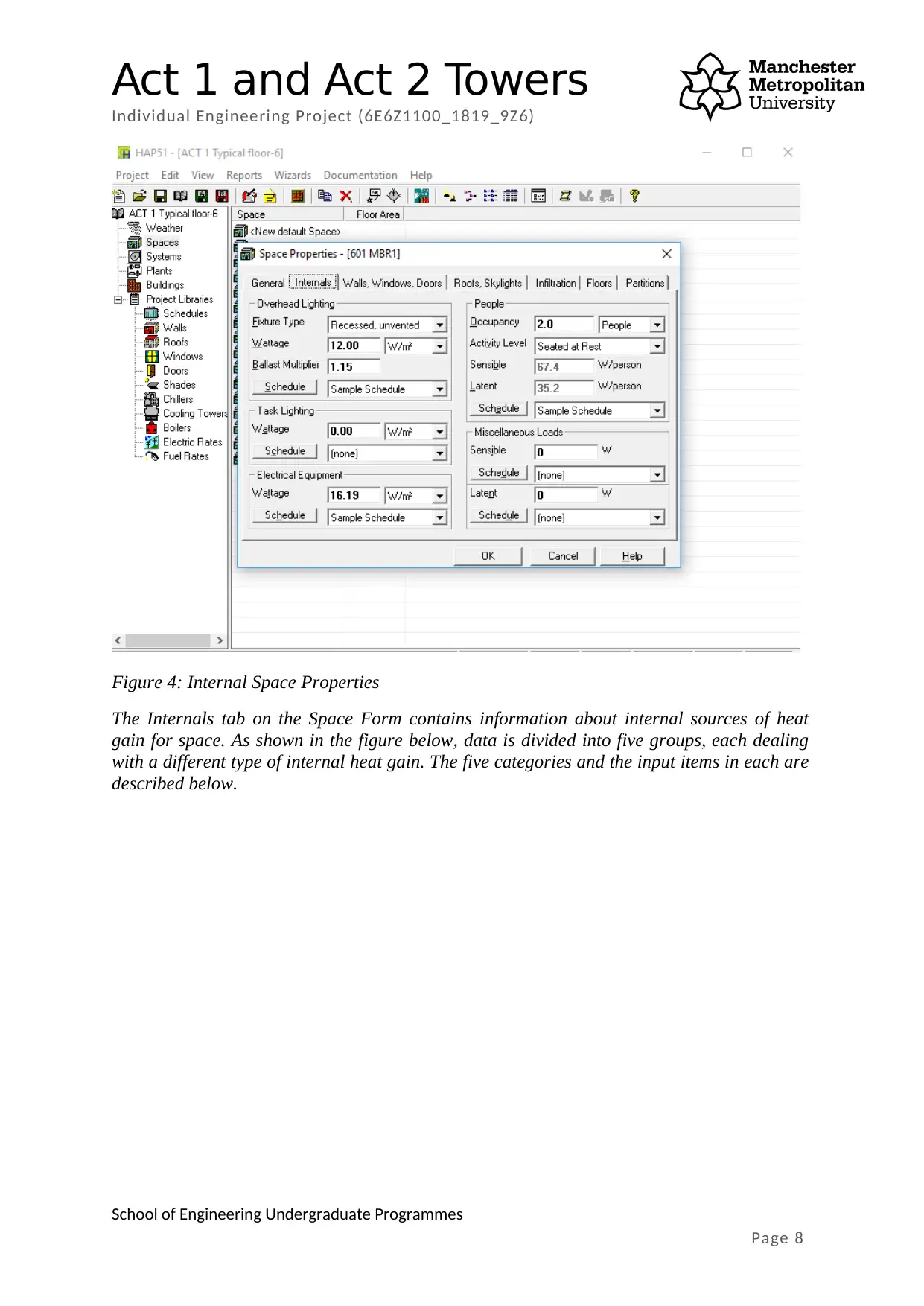
Act 1 and Act 2 Towers
Individual Engineering Project (6E6Z1100_1819_9Z6)
Figure 4: Internal Space Properties
The Internals tab on the Space Form contains information about internal sources of heat
gain for space. As shown in the figure below, data is divided into five groups, each dealing
with a different type of internal heat gain. The five categories and the input items in each are
described below.
School of Engineering Undergraduate Programmes
Page 8
Individual Engineering Project (6E6Z1100_1819_9Z6)
Figure 4: Internal Space Properties
The Internals tab on the Space Form contains information about internal sources of heat
gain for space. As shown in the figure below, data is divided into five groups, each dealing
with a different type of internal heat gain. The five categories and the input items in each are
described below.
School of Engineering Undergraduate Programmes
Page 8
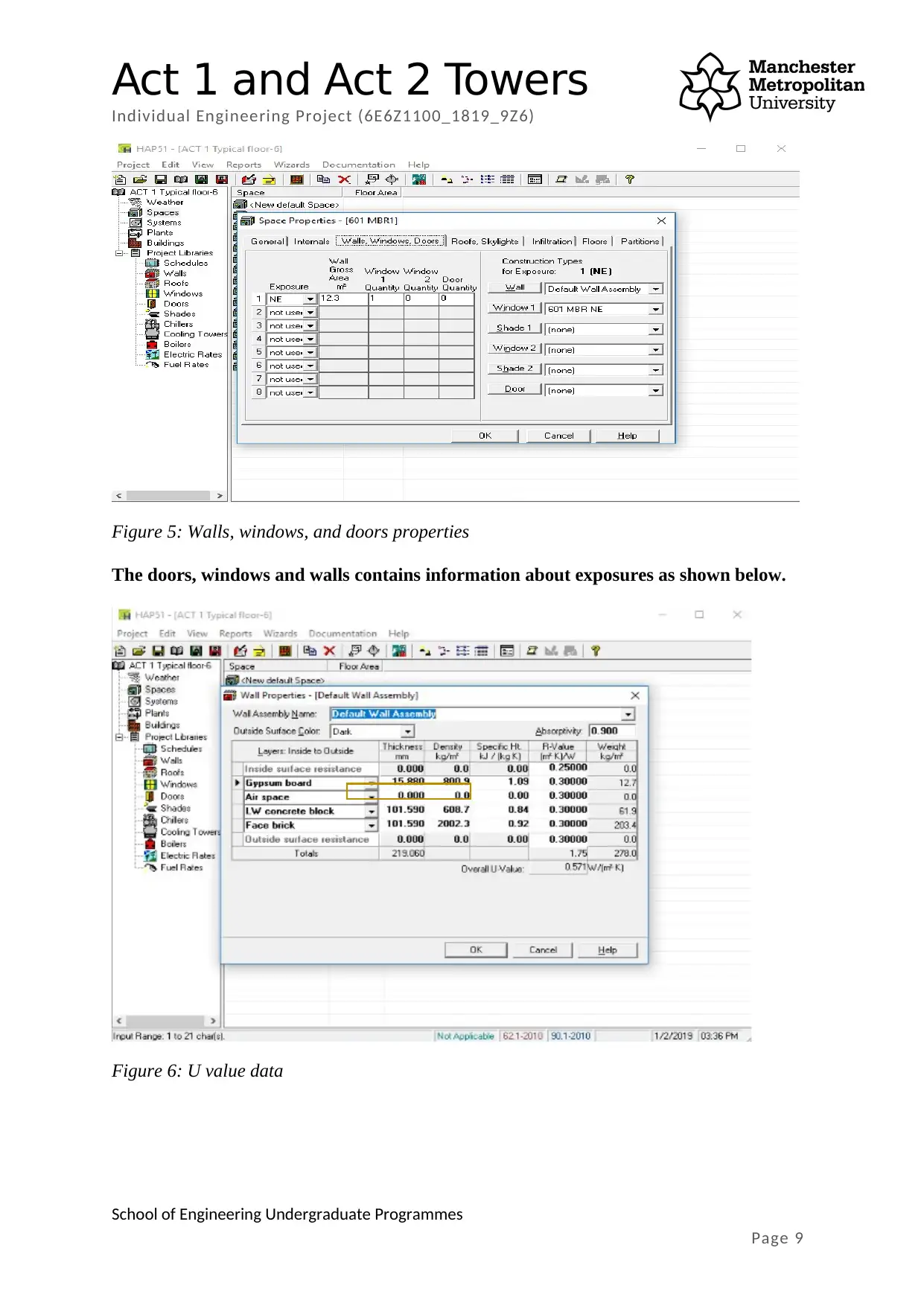
Act 1 and Act 2 Towers
Individual Engineering Project (6E6Z1100_1819_9Z6)
Figure 5: Walls, windows, and doors properties
The doors, windows and walls contains information about exposures as shown below.
Figure 6: U value data
School of Engineering Undergraduate Programmes
Page 9
Individual Engineering Project (6E6Z1100_1819_9Z6)
Figure 5: Walls, windows, and doors properties
The doors, windows and walls contains information about exposures as shown below.
Figure 6: U value data
School of Engineering Undergraduate Programmes
Page 9
Secure Best Marks with AI Grader
Need help grading? Try our AI Grader for instant feedback on your assignments.
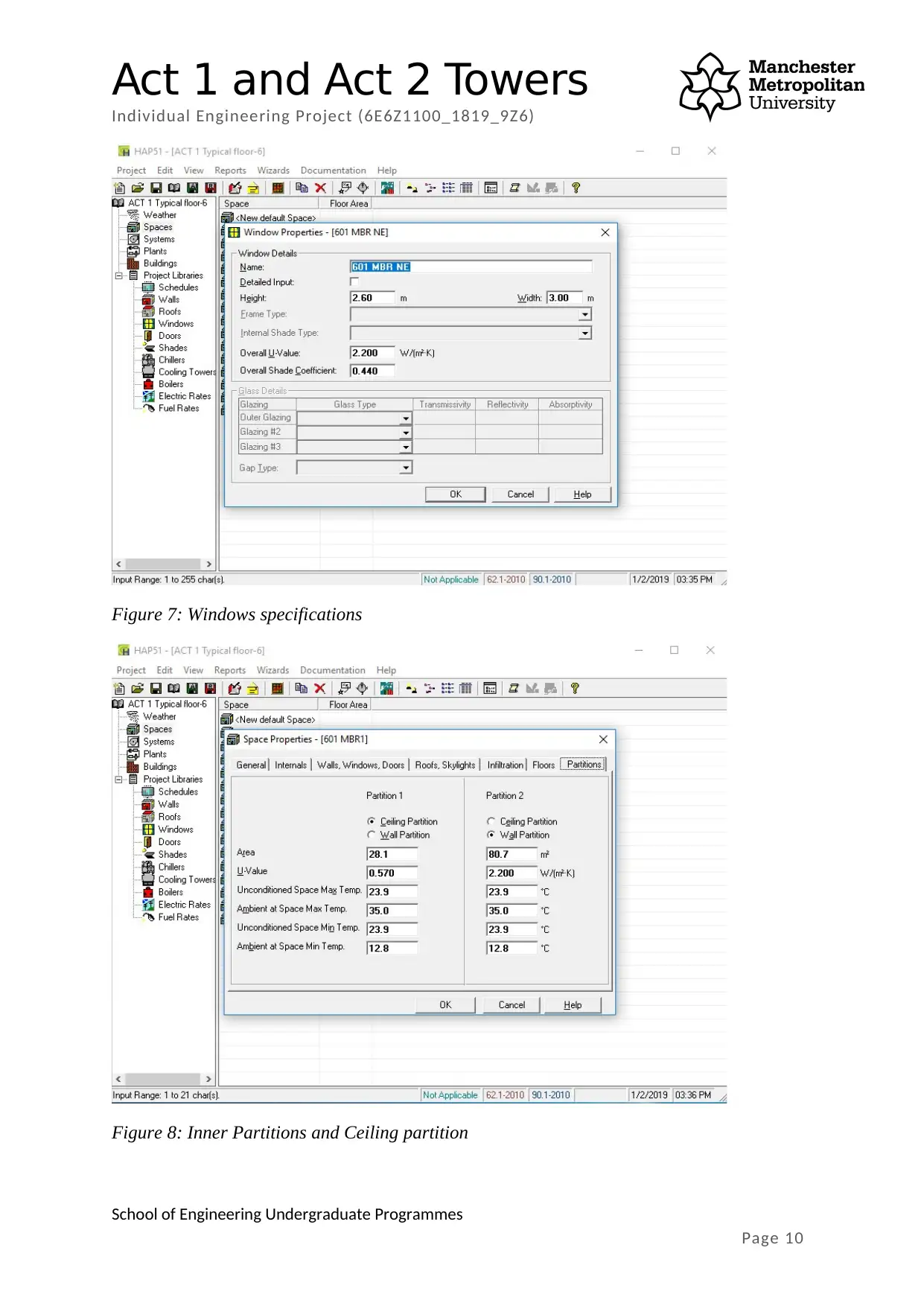
Act 1 and Act 2 Towers
Individual Engineering Project (6E6Z1100_1819_9Z6)
Figure 7: Windows specifications
Figure 8: Inner Partitions and Ceiling partition
School of Engineering Undergraduate Programmes
Page 10
Individual Engineering Project (6E6Z1100_1819_9Z6)
Figure 7: Windows specifications
Figure 8: Inner Partitions and Ceiling partition
School of Engineering Undergraduate Programmes
Page 10
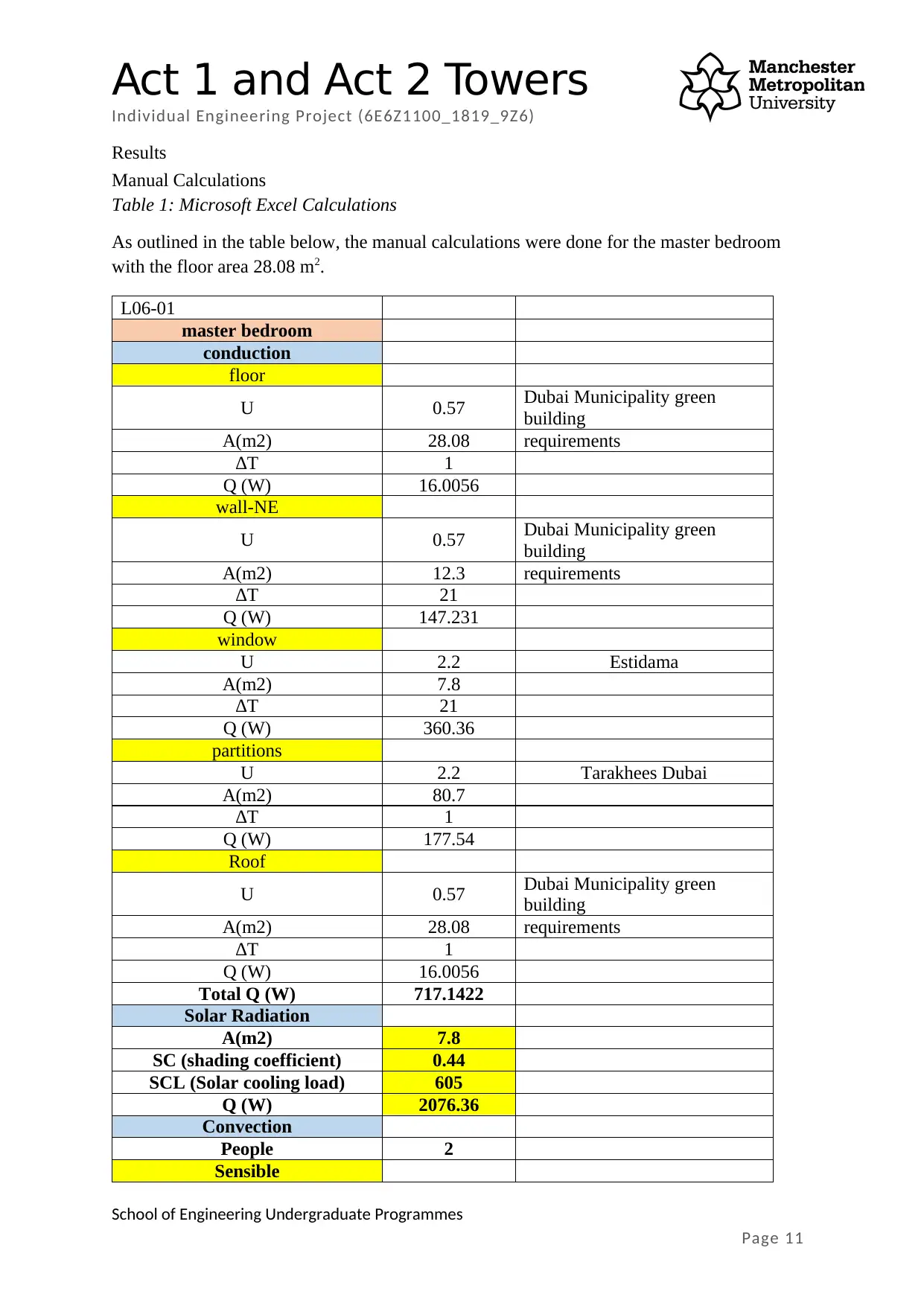
Act 1 and Act 2 Towers
Individual Engineering Project (6E6Z1100_1819_9Z6)
Results
Manual Calculations
Table 1: Microsoft Excel Calculations
As outlined in the table below, the manual calculations were done for the master bedroom
with the floor area 28.08 m2.
L06-01
master bedroom
conduction
floor
U 0.57 Dubai Municipality green
building
A(m2) 28.08 requirements
∆T 1
Q (W) 16.0056
wall-NE
U 0.57 Dubai Municipality green
building
A(m2) 12.3 requirements
∆T 21
Q (W) 147.231
window
U 2.2 Estidama
A(m2) 7.8
∆T 21
Q (W) 360.36
partitions
U 2.2 Tarakhees Dubai
A(m2) 80.7
∆T 1
Q (W) 177.54
Roof
U 0.57 Dubai Municipality green
building
A(m2) 28.08 requirements
∆T 1
Q (W) 16.0056
Total Q (W) 717.1422
Solar Radiation
A(m2) 7.8
SC (shading coefficient) 0.44
SCL (Solar cooling load) 605
Q (W) 2076.36
Convection
People 2
Sensible
School of Engineering Undergraduate Programmes
Page 11
Individual Engineering Project (6E6Z1100_1819_9Z6)
Results
Manual Calculations
Table 1: Microsoft Excel Calculations
As outlined in the table below, the manual calculations were done for the master bedroom
with the floor area 28.08 m2.
L06-01
master bedroom
conduction
floor
U 0.57 Dubai Municipality green
building
A(m2) 28.08 requirements
∆T 1
Q (W) 16.0056
wall-NE
U 0.57 Dubai Municipality green
building
A(m2) 12.3 requirements
∆T 21
Q (W) 147.231
window
U 2.2 Estidama
A(m2) 7.8
∆T 21
Q (W) 360.36
partitions
U 2.2 Tarakhees Dubai
A(m2) 80.7
∆T 1
Q (W) 177.54
Roof
U 0.57 Dubai Municipality green
building
A(m2) 28.08 requirements
∆T 1
Q (W) 16.0056
Total Q (W) 717.1422
Solar Radiation
A(m2) 7.8
SC (shading coefficient) 0.44
SCL (Solar cooling load) 605
Q (W) 2076.36
Convection
People 2
Sensible
School of Engineering Undergraduate Programmes
Page 11
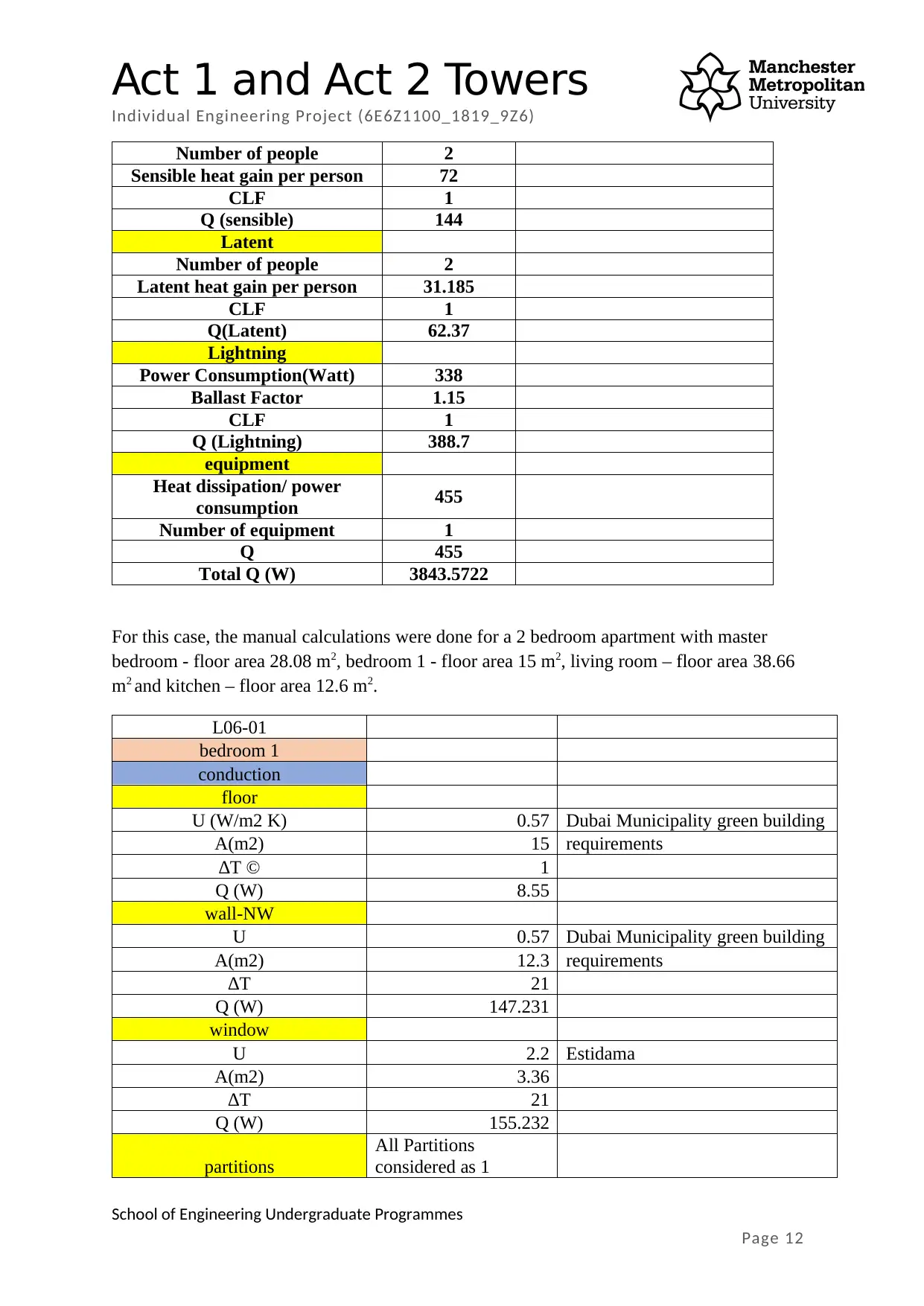
Act 1 and Act 2 Towers
Individual Engineering Project (6E6Z1100_1819_9Z6)
Number of people 2
Sensible heat gain per person 72
CLF 1
Q (sensible) 144
Latent
Number of people 2
Latent heat gain per person 31.185
CLF 1
Q(Latent) 62.37
Lightning
Power Consumption(Watt) 338
Ballast Factor 1.15
CLF 1
Q (Lightning) 388.7
equipment
Heat dissipation/ power
consumption 455
Number of equipment 1
Q 455
Total Q (W) 3843.5722
For this case, the manual calculations were done for a 2 bedroom apartment with master
bedroom - floor area 28.08 m2, bedroom 1 - floor area 15 m2, living room – floor area 38.66
m2 and kitchen – floor area 12.6 m2.
L06-01
bedroom 1
conduction
floor
U (W/m2 K) 0.57 Dubai Municipality green building
A(m2) 15 requirements
∆T © 1
Q (W) 8.55
wall-NW
U 0.57 Dubai Municipality green building
A(m2) 12.3 requirements
∆T 21
Q (W) 147.231
window
U 2.2 Estidama
A(m2) 3.36
∆T 21
Q (W) 155.232
partitions
All Partitions
considered as 1
School of Engineering Undergraduate Programmes
Page 12
Individual Engineering Project (6E6Z1100_1819_9Z6)
Number of people 2
Sensible heat gain per person 72
CLF 1
Q (sensible) 144
Latent
Number of people 2
Latent heat gain per person 31.185
CLF 1
Q(Latent) 62.37
Lightning
Power Consumption(Watt) 338
Ballast Factor 1.15
CLF 1
Q (Lightning) 388.7
equipment
Heat dissipation/ power
consumption 455
Number of equipment 1
Q 455
Total Q (W) 3843.5722
For this case, the manual calculations were done for a 2 bedroom apartment with master
bedroom - floor area 28.08 m2, bedroom 1 - floor area 15 m2, living room – floor area 38.66
m2 and kitchen – floor area 12.6 m2.
L06-01
bedroom 1
conduction
floor
U (W/m2 K) 0.57 Dubai Municipality green building
A(m2) 15 requirements
∆T © 1
Q (W) 8.55
wall-NW
U 0.57 Dubai Municipality green building
A(m2) 12.3 requirements
∆T 21
Q (W) 147.231
window
U 2.2 Estidama
A(m2) 3.36
∆T 21
Q (W) 155.232
partitions
All Partitions
considered as 1
School of Engineering Undergraduate Programmes
Page 12
Paraphrase This Document
Need a fresh take? Get an instant paraphrase of this document with our AI Paraphraser
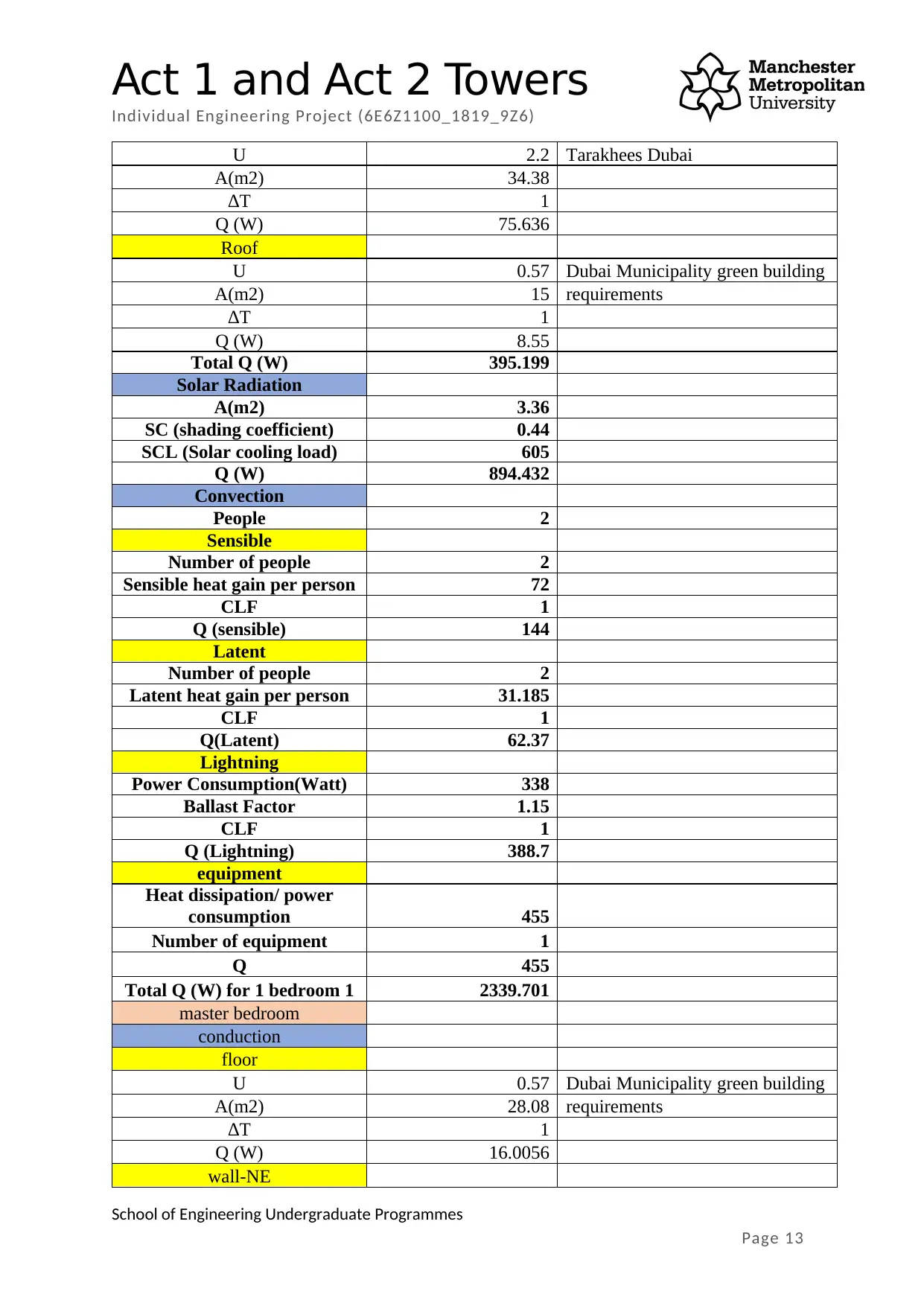
Act 1 and Act 2 Towers
Individual Engineering Project (6E6Z1100_1819_9Z6)
U 2.2 Tarakhees Dubai
A(m2) 34.38
∆T 1
Q (W) 75.636
Roof
U 0.57 Dubai Municipality green building
A(m2) 15 requirements
∆T 1
Q (W) 8.55
Total Q (W) 395.199
Solar Radiation
A(m2) 3.36
SC (shading coefficient) 0.44
SCL (Solar cooling load) 605
Q (W) 894.432
Convection
People 2
Sensible
Number of people 2
Sensible heat gain per person 72
CLF 1
Q (sensible) 144
Latent
Number of people 2
Latent heat gain per person 31.185
CLF 1
Q(Latent) 62.37
Lightning
Power Consumption(Watt) 338
Ballast Factor 1.15
CLF 1
Q (Lightning) 388.7
equipment
Heat dissipation/ power
consumption 455
Number of equipment 1
Q 455
Total Q (W) for 1 bedroom 1 2339.701
master bedroom
conduction
floor
U 0.57 Dubai Municipality green building
A(m2) 28.08 requirements
∆T 1
Q (W) 16.0056
wall-NE
School of Engineering Undergraduate Programmes
Page 13
Individual Engineering Project (6E6Z1100_1819_9Z6)
U 2.2 Tarakhees Dubai
A(m2) 34.38
∆T 1
Q (W) 75.636
Roof
U 0.57 Dubai Municipality green building
A(m2) 15 requirements
∆T 1
Q (W) 8.55
Total Q (W) 395.199
Solar Radiation
A(m2) 3.36
SC (shading coefficient) 0.44
SCL (Solar cooling load) 605
Q (W) 894.432
Convection
People 2
Sensible
Number of people 2
Sensible heat gain per person 72
CLF 1
Q (sensible) 144
Latent
Number of people 2
Latent heat gain per person 31.185
CLF 1
Q(Latent) 62.37
Lightning
Power Consumption(Watt) 338
Ballast Factor 1.15
CLF 1
Q (Lightning) 388.7
equipment
Heat dissipation/ power
consumption 455
Number of equipment 1
Q 455
Total Q (W) for 1 bedroom 1 2339.701
master bedroom
conduction
floor
U 0.57 Dubai Municipality green building
A(m2) 28.08 requirements
∆T 1
Q (W) 16.0056
wall-NE
School of Engineering Undergraduate Programmes
Page 13
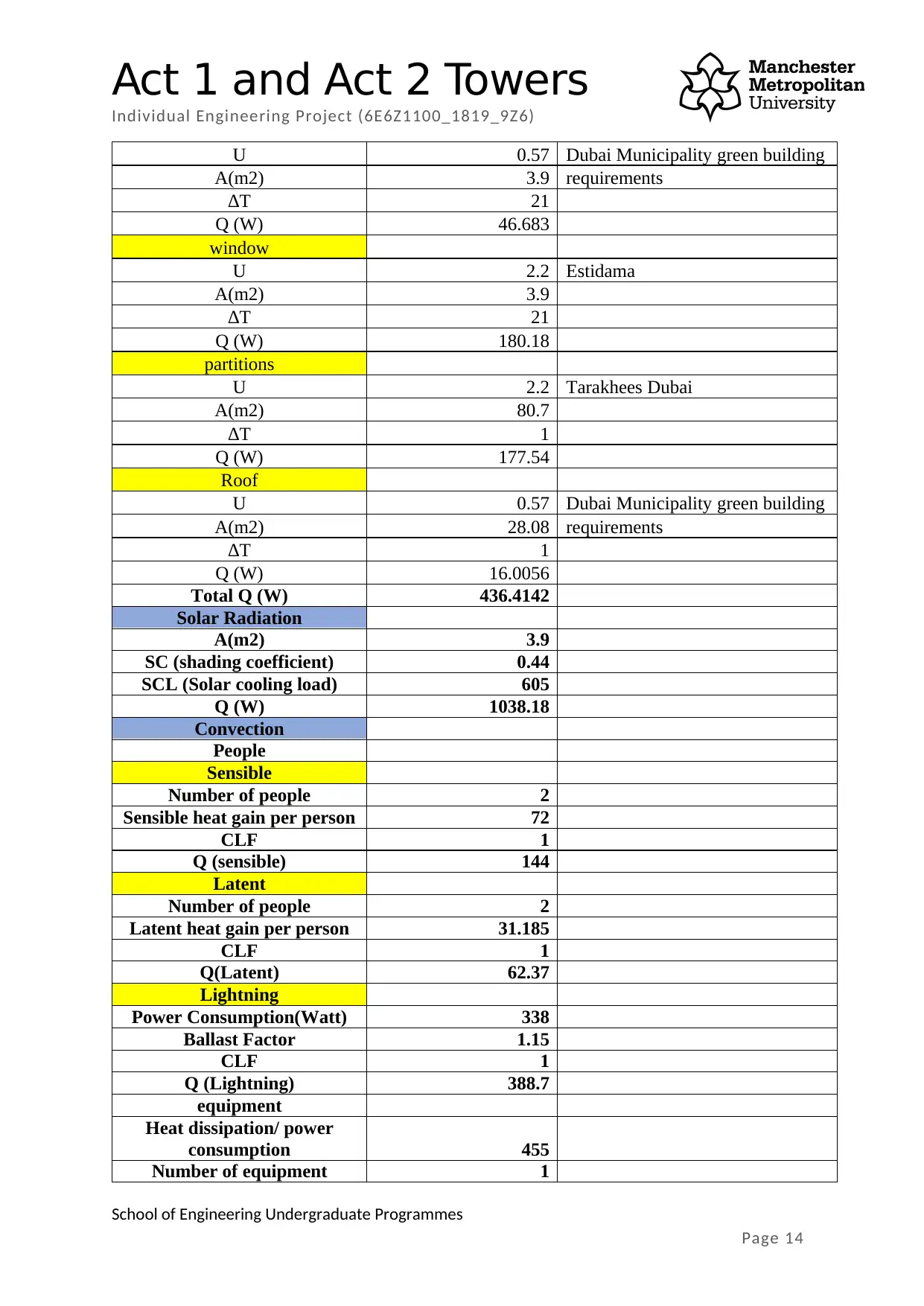
Act 1 and Act 2 Towers
Individual Engineering Project (6E6Z1100_1819_9Z6)
U 0.57 Dubai Municipality green building
A(m2) 3.9 requirements
∆T 21
Q (W) 46.683
window
U 2.2 Estidama
A(m2) 3.9
∆T 21
Q (W) 180.18
partitions
U 2.2 Tarakhees Dubai
A(m2) 80.7
∆T 1
Q (W) 177.54
Roof
U 0.57 Dubai Municipality green building
A(m2) 28.08 requirements
∆T 1
Q (W) 16.0056
Total Q (W) 436.4142
Solar Radiation
A(m2) 3.9
SC (shading coefficient) 0.44
SCL (Solar cooling load) 605
Q (W) 1038.18
Convection
People
Sensible
Number of people 2
Sensible heat gain per person 72
CLF 1
Q (sensible) 144
Latent
Number of people 2
Latent heat gain per person 31.185
CLF 1
Q(Latent) 62.37
Lightning
Power Consumption(Watt) 338
Ballast Factor 1.15
CLF 1
Q (Lightning) 388.7
equipment
Heat dissipation/ power
consumption 455
Number of equipment 1
School of Engineering Undergraduate Programmes
Page 14
Individual Engineering Project (6E6Z1100_1819_9Z6)
U 0.57 Dubai Municipality green building
A(m2) 3.9 requirements
∆T 21
Q (W) 46.683
window
U 2.2 Estidama
A(m2) 3.9
∆T 21
Q (W) 180.18
partitions
U 2.2 Tarakhees Dubai
A(m2) 80.7
∆T 1
Q (W) 177.54
Roof
U 0.57 Dubai Municipality green building
A(m2) 28.08 requirements
∆T 1
Q (W) 16.0056
Total Q (W) 436.4142
Solar Radiation
A(m2) 3.9
SC (shading coefficient) 0.44
SCL (Solar cooling load) 605
Q (W) 1038.18
Convection
People
Sensible
Number of people 2
Sensible heat gain per person 72
CLF 1
Q (sensible) 144
Latent
Number of people 2
Latent heat gain per person 31.185
CLF 1
Q(Latent) 62.37
Lightning
Power Consumption(Watt) 338
Ballast Factor 1.15
CLF 1
Q (Lightning) 388.7
equipment
Heat dissipation/ power
consumption 455
Number of equipment 1
School of Engineering Undergraduate Programmes
Page 14
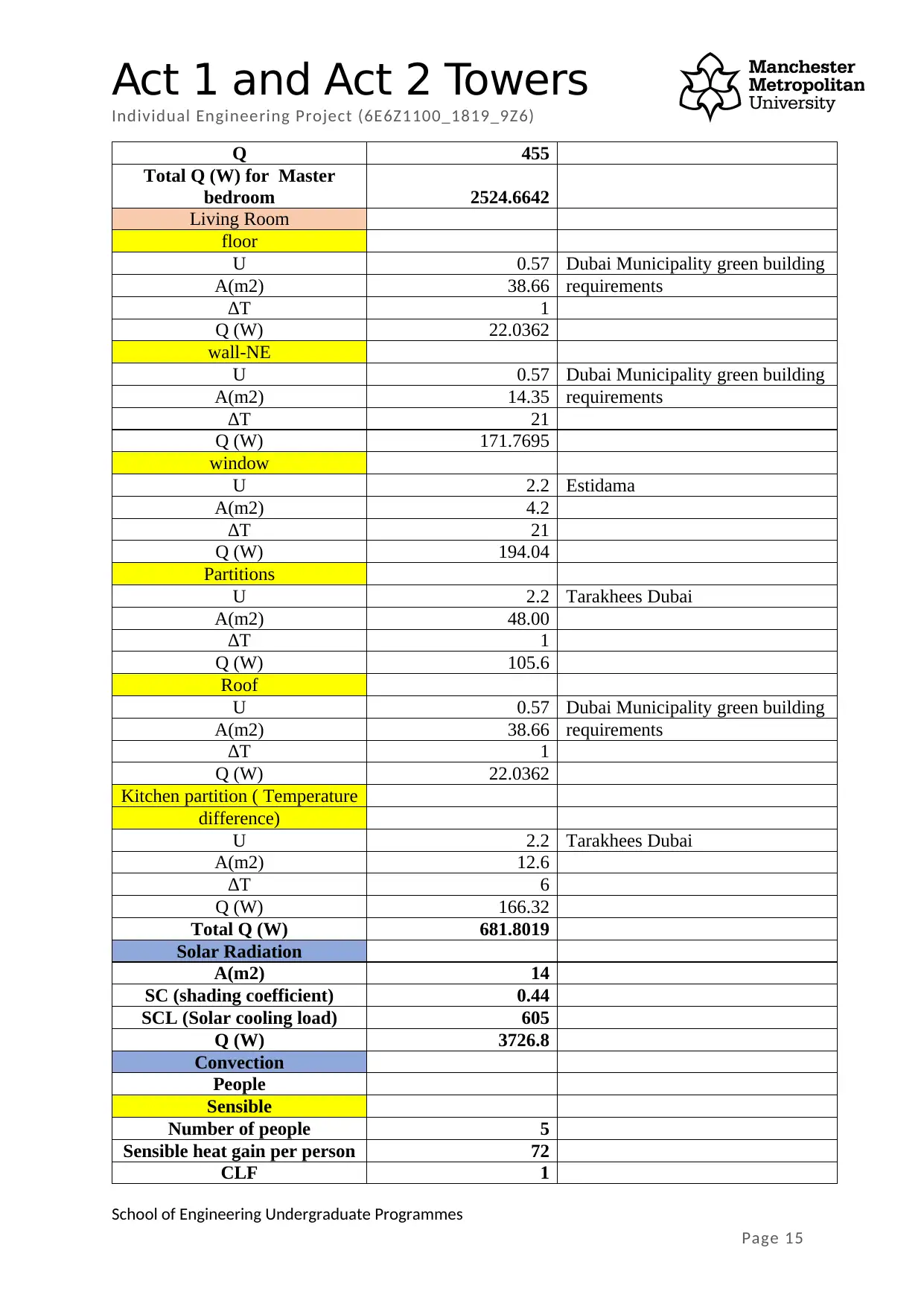
Act 1 and Act 2 Towers
Individual Engineering Project (6E6Z1100_1819_9Z6)
Q 455
Total Q (W) for Master
bedroom 2524.6642
Living Room
floor
U 0.57 Dubai Municipality green building
A(m2) 38.66 requirements
∆T 1
Q (W) 22.0362
wall-NE
U 0.57 Dubai Municipality green building
A(m2) 14.35 requirements
∆T 21
Q (W) 171.7695
window
U 2.2 Estidama
A(m2) 4.2
∆T 21
Q (W) 194.04
Partitions
U 2.2 Tarakhees Dubai
A(m2) 48.00
∆T 1
Q (W) 105.6
Roof
U 0.57 Dubai Municipality green building
A(m2) 38.66 requirements
∆T 1
Q (W) 22.0362
Kitchen partition ( Temperature
difference)
U 2.2 Tarakhees Dubai
A(m2) 12.6
∆T 6
Q (W) 166.32
Total Q (W) 681.8019
Solar Radiation
A(m2) 14
SC (shading coefficient) 0.44
SCL (Solar cooling load) 605
Q (W) 3726.8
Convection
People
Sensible
Number of people 5
Sensible heat gain per person 72
CLF 1
School of Engineering Undergraduate Programmes
Page 15
Individual Engineering Project (6E6Z1100_1819_9Z6)
Q 455
Total Q (W) for Master
bedroom 2524.6642
Living Room
floor
U 0.57 Dubai Municipality green building
A(m2) 38.66 requirements
∆T 1
Q (W) 22.0362
wall-NE
U 0.57 Dubai Municipality green building
A(m2) 14.35 requirements
∆T 21
Q (W) 171.7695
window
U 2.2 Estidama
A(m2) 4.2
∆T 21
Q (W) 194.04
Partitions
U 2.2 Tarakhees Dubai
A(m2) 48.00
∆T 1
Q (W) 105.6
Roof
U 0.57 Dubai Municipality green building
A(m2) 38.66 requirements
∆T 1
Q (W) 22.0362
Kitchen partition ( Temperature
difference)
U 2.2 Tarakhees Dubai
A(m2) 12.6
∆T 6
Q (W) 166.32
Total Q (W) 681.8019
Solar Radiation
A(m2) 14
SC (shading coefficient) 0.44
SCL (Solar cooling load) 605
Q (W) 3726.8
Convection
People
Sensible
Number of people 5
Sensible heat gain per person 72
CLF 1
School of Engineering Undergraduate Programmes
Page 15
Secure Best Marks with AI Grader
Need help grading? Try our AI Grader for instant feedback on your assignments.

Act 1 and Act 2 Towers
Individual Engineering Project (6E6Z1100_1819_9Z6)
Q (sensible) 360
Latent
Number of people 5
Latent heat gain per person 31.185
CLF 1
Q(Latent) 155.925
Lightning
Power Consumption(Watt) 338
Ballast Factor 1.15
CLF 1
Q (Lightning) 388.7
equipment
Heat dissipation/ power
consumption 455
Number of equipment 1
Q 455
Total Q (W) for Living room 5768.2269
Total Q for the Apartment 10632.5921
For this case, the manual calculations were done for a 2 bedroom apartment with master
bedroom - floor area 28.08 m2, bedroom 1 - floor area 13 m2, living room – floor area 48.2 m2
and kitchen – floor area 12.6 m2.
L06-08
bedroom 1
conduction
floor
U (W/m2 K) 0.57
Dubai Municipality green
building
A(m2) 13 requirements
∆T © 1
Q (W) 7.41
wall-NW
U 0.57
Dubai Municipality green
building
A(m2) 12.3 requirements
∆T 21
Q (W) 147.231
window
U 2.2 Estidama
A(m2) 3.36
∆T 21
Q (W) 155.232
partitions
All Partitions
considered as 1
School of Engineering Undergraduate Programmes
Page 16
Individual Engineering Project (6E6Z1100_1819_9Z6)
Q (sensible) 360
Latent
Number of people 5
Latent heat gain per person 31.185
CLF 1
Q(Latent) 155.925
Lightning
Power Consumption(Watt) 338
Ballast Factor 1.15
CLF 1
Q (Lightning) 388.7
equipment
Heat dissipation/ power
consumption 455
Number of equipment 1
Q 455
Total Q (W) for Living room 5768.2269
Total Q for the Apartment 10632.5921
For this case, the manual calculations were done for a 2 bedroom apartment with master
bedroom - floor area 28.08 m2, bedroom 1 - floor area 13 m2, living room – floor area 48.2 m2
and kitchen – floor area 12.6 m2.
L06-08
bedroom 1
conduction
floor
U (W/m2 K) 0.57
Dubai Municipality green
building
A(m2) 13 requirements
∆T © 1
Q (W) 7.41
wall-NW
U 0.57
Dubai Municipality green
building
A(m2) 12.3 requirements
∆T 21
Q (W) 147.231
window
U 2.2 Estidama
A(m2) 3.36
∆T 21
Q (W) 155.232
partitions
All Partitions
considered as 1
School of Engineering Undergraduate Programmes
Page 16
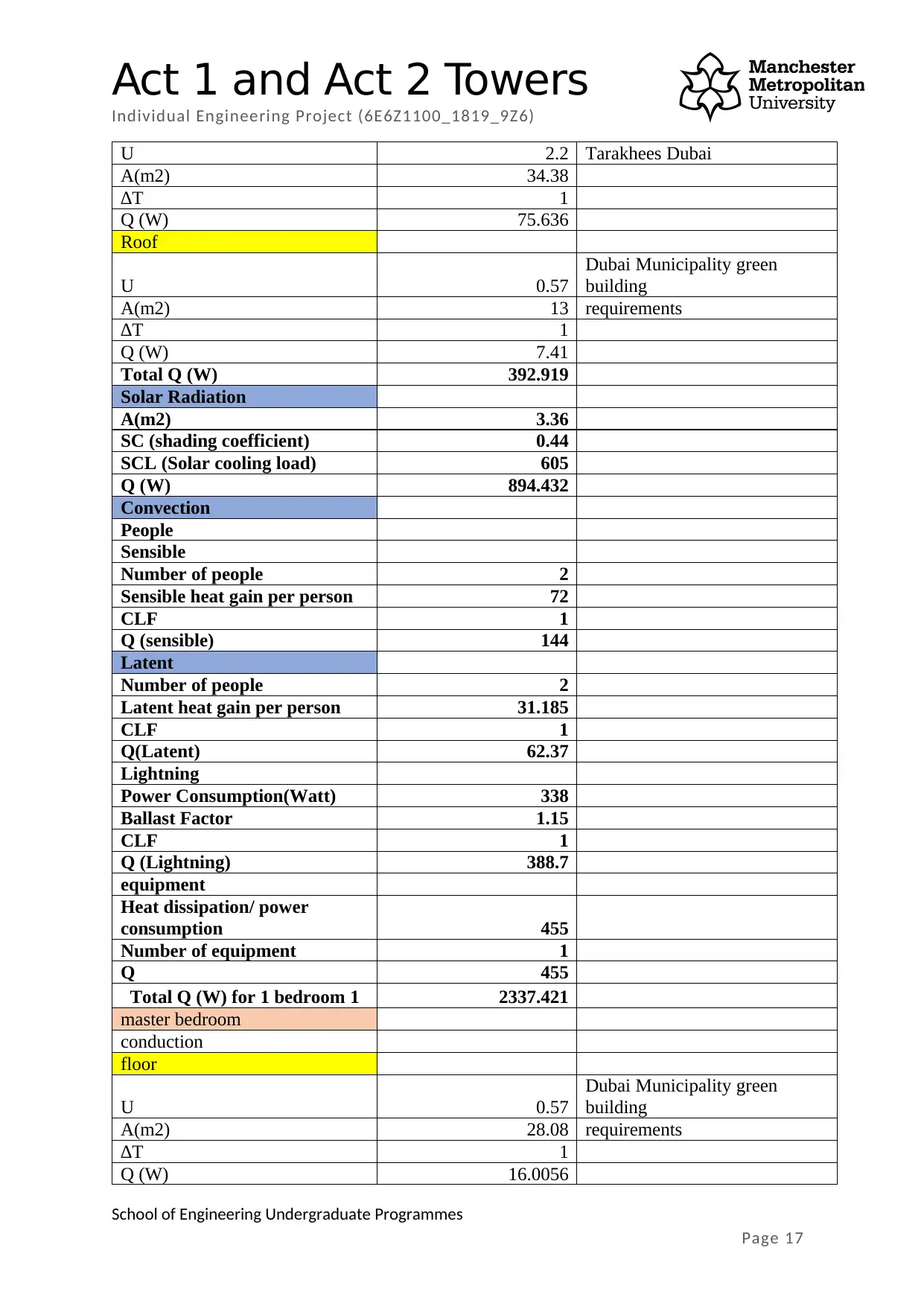
Act 1 and Act 2 Towers
Individual Engineering Project (6E6Z1100_1819_9Z6)
U 2.2 Tarakhees Dubai
A(m2) 34.38
∆T 1
Q (W) 75.636
Roof
U 0.57
Dubai Municipality green
building
A(m2) 13 requirements
∆T 1
Q (W) 7.41
Total Q (W) 392.919
Solar Radiation
A(m2) 3.36
SC (shading coefficient) 0.44
SCL (Solar cooling load) 605
Q (W) 894.432
Convection
People
Sensible
Number of people 2
Sensible heat gain per person 72
CLF 1
Q (sensible) 144
Latent
Number of people 2
Latent heat gain per person 31.185
CLF 1
Q(Latent) 62.37
Lightning
Power Consumption(Watt) 338
Ballast Factor 1.15
CLF 1
Q (Lightning) 388.7
equipment
Heat dissipation/ power
consumption 455
Number of equipment 1
Q 455
Total Q (W) for 1 bedroom 1 2337.421
master bedroom
conduction
floor
U 0.57
Dubai Municipality green
building
A(m2) 28.08 requirements
∆T 1
Q (W) 16.0056
School of Engineering Undergraduate Programmes
Page 17
Individual Engineering Project (6E6Z1100_1819_9Z6)
U 2.2 Tarakhees Dubai
A(m2) 34.38
∆T 1
Q (W) 75.636
Roof
U 0.57
Dubai Municipality green
building
A(m2) 13 requirements
∆T 1
Q (W) 7.41
Total Q (W) 392.919
Solar Radiation
A(m2) 3.36
SC (shading coefficient) 0.44
SCL (Solar cooling load) 605
Q (W) 894.432
Convection
People
Sensible
Number of people 2
Sensible heat gain per person 72
CLF 1
Q (sensible) 144
Latent
Number of people 2
Latent heat gain per person 31.185
CLF 1
Q(Latent) 62.37
Lightning
Power Consumption(Watt) 338
Ballast Factor 1.15
CLF 1
Q (Lightning) 388.7
equipment
Heat dissipation/ power
consumption 455
Number of equipment 1
Q 455
Total Q (W) for 1 bedroom 1 2337.421
master bedroom
conduction
floor
U 0.57
Dubai Municipality green
building
A(m2) 28.08 requirements
∆T 1
Q (W) 16.0056
School of Engineering Undergraduate Programmes
Page 17
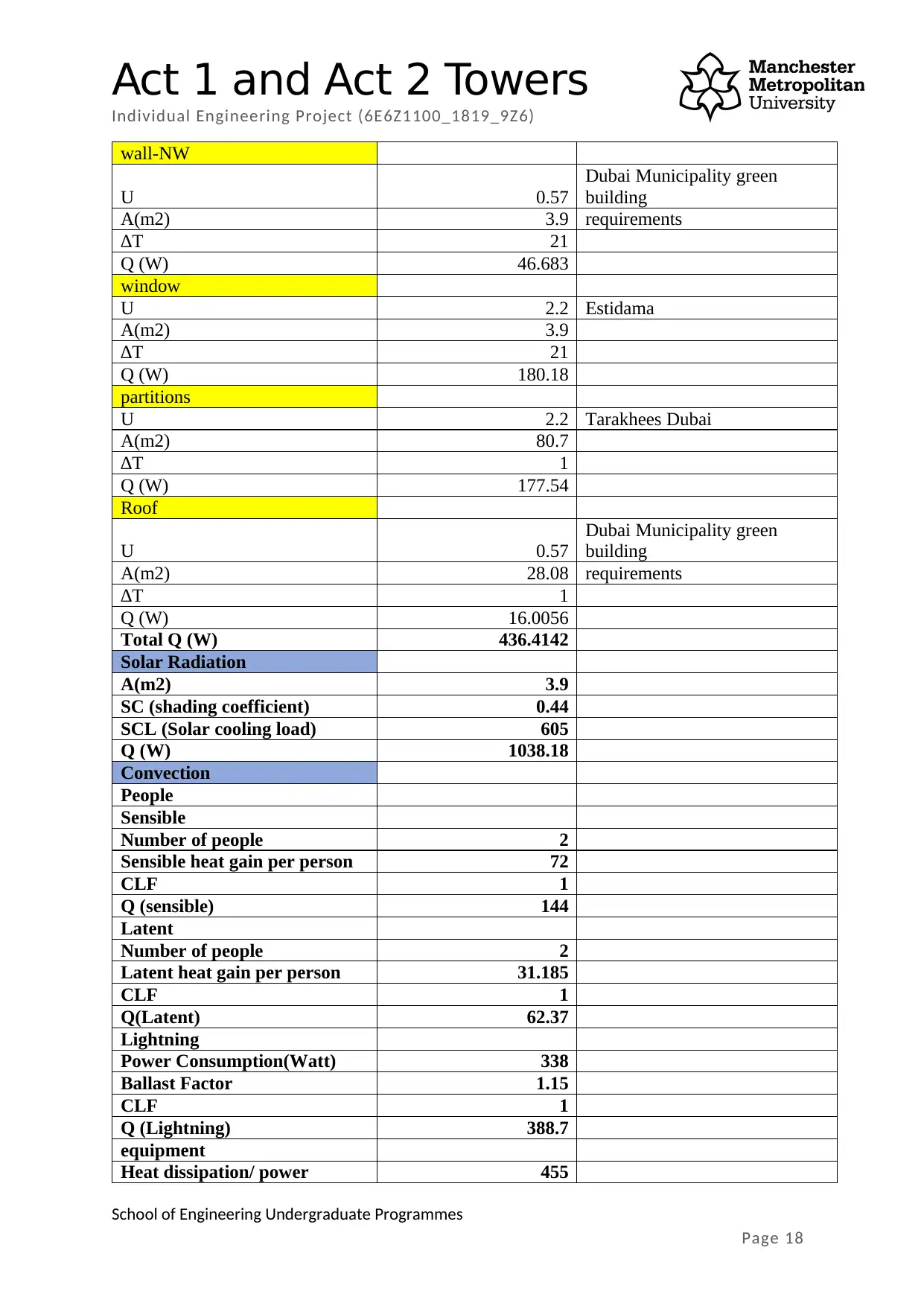
Act 1 and Act 2 Towers
Individual Engineering Project (6E6Z1100_1819_9Z6)
wall-NW
U 0.57
Dubai Municipality green
building
A(m2) 3.9 requirements
∆T 21
Q (W) 46.683
window
U 2.2 Estidama
A(m2) 3.9
∆T 21
Q (W) 180.18
partitions
U 2.2 Tarakhees Dubai
A(m2) 80.7
∆T 1
Q (W) 177.54
Roof
U 0.57
Dubai Municipality green
building
A(m2) 28.08 requirements
∆T 1
Q (W) 16.0056
Total Q (W) 436.4142
Solar Radiation
A(m2) 3.9
SC (shading coefficient) 0.44
SCL (Solar cooling load) 605
Q (W) 1038.18
Convection
People
Sensible
Number of people 2
Sensible heat gain per person 72
CLF 1
Q (sensible) 144
Latent
Number of people 2
Latent heat gain per person 31.185
CLF 1
Q(Latent) 62.37
Lightning
Power Consumption(Watt) 338
Ballast Factor 1.15
CLF 1
Q (Lightning) 388.7
equipment
Heat dissipation/ power 455
School of Engineering Undergraduate Programmes
Page 18
Individual Engineering Project (6E6Z1100_1819_9Z6)
wall-NW
U 0.57
Dubai Municipality green
building
A(m2) 3.9 requirements
∆T 21
Q (W) 46.683
window
U 2.2 Estidama
A(m2) 3.9
∆T 21
Q (W) 180.18
partitions
U 2.2 Tarakhees Dubai
A(m2) 80.7
∆T 1
Q (W) 177.54
Roof
U 0.57
Dubai Municipality green
building
A(m2) 28.08 requirements
∆T 1
Q (W) 16.0056
Total Q (W) 436.4142
Solar Radiation
A(m2) 3.9
SC (shading coefficient) 0.44
SCL (Solar cooling load) 605
Q (W) 1038.18
Convection
People
Sensible
Number of people 2
Sensible heat gain per person 72
CLF 1
Q (sensible) 144
Latent
Number of people 2
Latent heat gain per person 31.185
CLF 1
Q(Latent) 62.37
Lightning
Power Consumption(Watt) 338
Ballast Factor 1.15
CLF 1
Q (Lightning) 388.7
equipment
Heat dissipation/ power 455
School of Engineering Undergraduate Programmes
Page 18
Paraphrase This Document
Need a fresh take? Get an instant paraphrase of this document with our AI Paraphraser
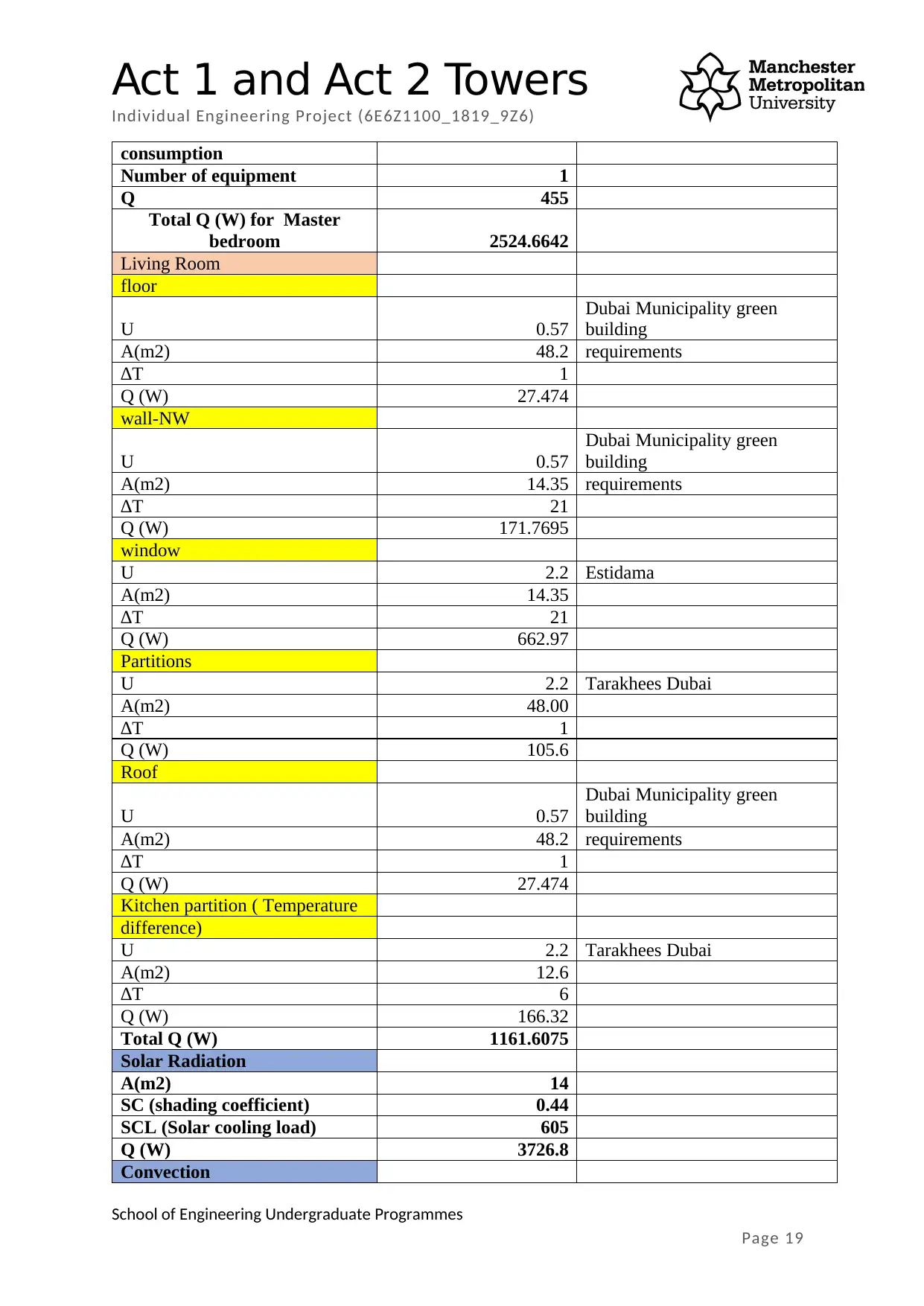
Act 1 and Act 2 Towers
Individual Engineering Project (6E6Z1100_1819_9Z6)
consumption
Number of equipment 1
Q 455
Total Q (W) for Master
bedroom 2524.6642
Living Room
floor
U 0.57
Dubai Municipality green
building
A(m2) 48.2 requirements
∆T 1
Q (W) 27.474
wall-NW
U 0.57
Dubai Municipality green
building
A(m2) 14.35 requirements
∆T 21
Q (W) 171.7695
window
U 2.2 Estidama
A(m2) 14.35
∆T 21
Q (W) 662.97
Partitions
U 2.2 Tarakhees Dubai
A(m2) 48.00
∆T 1
Q (W) 105.6
Roof
U 0.57
Dubai Municipality green
building
A(m2) 48.2 requirements
∆T 1
Q (W) 27.474
Kitchen partition ( Temperature
difference)
U 2.2 Tarakhees Dubai
A(m2) 12.6
∆T 6
Q (W) 166.32
Total Q (W) 1161.6075
Solar Radiation
A(m2) 14
SC (shading coefficient) 0.44
SCL (Solar cooling load) 605
Q (W) 3726.8
Convection
School of Engineering Undergraduate Programmes
Page 19
Individual Engineering Project (6E6Z1100_1819_9Z6)
consumption
Number of equipment 1
Q 455
Total Q (W) for Master
bedroom 2524.6642
Living Room
floor
U 0.57
Dubai Municipality green
building
A(m2) 48.2 requirements
∆T 1
Q (W) 27.474
wall-NW
U 0.57
Dubai Municipality green
building
A(m2) 14.35 requirements
∆T 21
Q (W) 171.7695
window
U 2.2 Estidama
A(m2) 14.35
∆T 21
Q (W) 662.97
Partitions
U 2.2 Tarakhees Dubai
A(m2) 48.00
∆T 1
Q (W) 105.6
Roof
U 0.57
Dubai Municipality green
building
A(m2) 48.2 requirements
∆T 1
Q (W) 27.474
Kitchen partition ( Temperature
difference)
U 2.2 Tarakhees Dubai
A(m2) 12.6
∆T 6
Q (W) 166.32
Total Q (W) 1161.6075
Solar Radiation
A(m2) 14
SC (shading coefficient) 0.44
SCL (Solar cooling load) 605
Q (W) 3726.8
Convection
School of Engineering Undergraduate Programmes
Page 19

Act 1 and Act 2 Towers
Individual Engineering Project (6E6Z1100_1819_9Z6)
People
Sensible
Number of people 5
Sensible heat gain per person 72
CLF 1
Q (sensible) 360
Latent
Number of people 5
Latent heat gain per person 31.185
CLF 1
Q(Latent) 155.925
Lightning
Power Consumption(Watt) 338
Ballast Factor 1.15
CLF 1
Q (Lightning) 388.7
equipment
Heat dissipation/ power
consumption 455
Number of equipment 1
Q
Total Q (W) for Living room 5793.0325
Total Q for the Apartment 10655.1177
Hourly Analysis Program (HAP):
Flat 601 Living Room Report:
Master Bedroom:
School of Engineering Undergraduate Programmes
Page 20
Individual Engineering Project (6E6Z1100_1819_9Z6)
People
Sensible
Number of people 5
Sensible heat gain per person 72
CLF 1
Q (sensible) 360
Latent
Number of people 5
Latent heat gain per person 31.185
CLF 1
Q(Latent) 155.925
Lightning
Power Consumption(Watt) 338
Ballast Factor 1.15
CLF 1
Q (Lightning) 388.7
equipment
Heat dissipation/ power
consumption 455
Number of equipment 1
Q
Total Q (W) for Living room 5793.0325
Total Q for the Apartment 10655.1177
Hourly Analysis Program (HAP):
Flat 601 Living Room Report:
Master Bedroom:
School of Engineering Undergraduate Programmes
Page 20
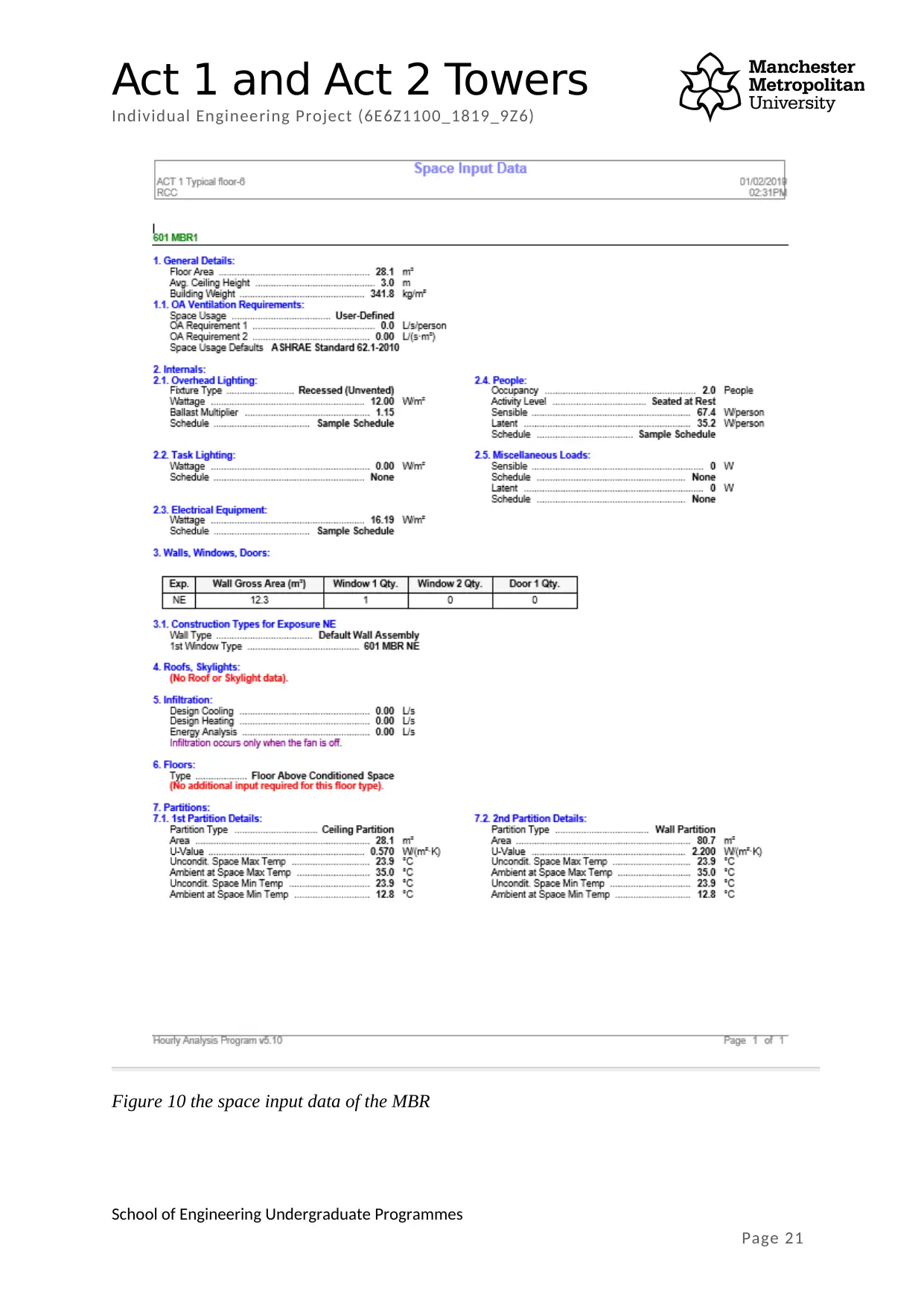
Act 1 and Act 2 Towers
Individual Engineering Project (6E6Z1100_1819_9Z6)
Figure 10 the space input data of the MBR
School of Engineering Undergraduate Programmes
Page 21
Individual Engineering Project (6E6Z1100_1819_9Z6)
Figure 10 the space input data of the MBR
School of Engineering Undergraduate Programmes
Page 21
Secure Best Marks with AI Grader
Need help grading? Try our AI Grader for instant feedback on your assignments.

Act 1 and Act 2 Towers
Individual Engineering Project (6E6Z1100_1819_9Z6)
Discussion
Sr.
No. Tag No. Space
AS PER CONSULTANT
CALCULATION
AS PER MANSOUR
CALCULATION FINDINGS
Air
flow
rate
(L/s)
Total
Capaci
ty
(KW)
Sensible
Capacity
(KW)
CHW
Flow
Rate
(L/s)
Air
flo
w
rate
(L/s
)
Total
Capaci
ty
(KW)
Sensible
Capacit
y
(KW)
CHW
Flow
Rate
(L/s)
Percentage
Error -
Cooling
Capacity
(%)
Percentag
e Error -
Air Flow
Rate (%)
Remarks
1 FCU-T1-
L06-01-1
LIVING
ROOM &
KITCHE
N
376 5.1 4.7 0.139 365 4.6 4.2 0.2 9.80 2.93
The calculations for
the cooling loads by
the student is well
within the range
required. Therefore,
the FCU selected by
the consultant will
comfortably work
for the rooms to be
cooled.
2 FCU-T1-
L06-01-2
MASTE
R BED
ROOM
161 2.2 2.1 0.06 187 2.2 2.1 0.09 0.00 -16.15
3 FCU-T1-
L06-01-3
BED
ROOM 126 1.8 1.7 0.049 150 1.7 1.7 0.07 5.56 -19.05
4 FCU-T1-
L06-03-1
LIVING
ROOM &
KITCHE
N
253 3.8 3.4 0.103 279 3.6 3.2 0.15 5.26 -10.28
In comparison of the
two calculations, the
positive error is well
within margin.
Notably, the
negative error
indicates that the
unit selected by the
5 FCU-T1-
L06-03-2
MASTER
BEDROO
M
204 2.8 2.7 0.076 253 3 2.9 0.13 -7.14 -24.02
6 FCU-T1- MASTER 196 2.7 2.6 0.073 252 2.9 2.8 0.13 -7.41 -28.57
School of Engineering Undergraduate Programmes Page 22
Individual Engineering Project (6E6Z1100_1819_9Z6)
Discussion
Sr.
No. Tag No. Space
AS PER CONSULTANT
CALCULATION
AS PER MANSOUR
CALCULATION FINDINGS
Air
flow
rate
(L/s)
Total
Capaci
ty
(KW)
Sensible
Capacity
(KW)
CHW
Flow
Rate
(L/s)
Air
flo
w
rate
(L/s
)
Total
Capaci
ty
(KW)
Sensible
Capacit
y
(KW)
CHW
Flow
Rate
(L/s)
Percentage
Error -
Cooling
Capacity
(%)
Percentag
e Error -
Air Flow
Rate (%)
Remarks
1 FCU-T1-
L06-01-1
LIVING
ROOM &
KITCHE
N
376 5.1 4.7 0.139 365 4.6 4.2 0.2 9.80 2.93
The calculations for
the cooling loads by
the student is well
within the range
required. Therefore,
the FCU selected by
the consultant will
comfortably work
for the rooms to be
cooled.
2 FCU-T1-
L06-01-2
MASTE
R BED
ROOM
161 2.2 2.1 0.06 187 2.2 2.1 0.09 0.00 -16.15
3 FCU-T1-
L06-01-3
BED
ROOM 126 1.8 1.7 0.049 150 1.7 1.7 0.07 5.56 -19.05
4 FCU-T1-
L06-03-1
LIVING
ROOM &
KITCHE
N
253 3.8 3.4 0.103 279 3.6 3.2 0.15 5.26 -10.28
In comparison of the
two calculations, the
positive error is well
within margin.
Notably, the
negative error
indicates that the
unit selected by the
5 FCU-T1-
L06-03-2
MASTER
BEDROO
M
204 2.8 2.7 0.076 253 3 2.9 0.13 -7.14 -24.02
6 FCU-T1- MASTER 196 2.7 2.6 0.073 252 2.9 2.8 0.13 -7.41 -28.57
School of Engineering Undergraduate Programmes Page 22
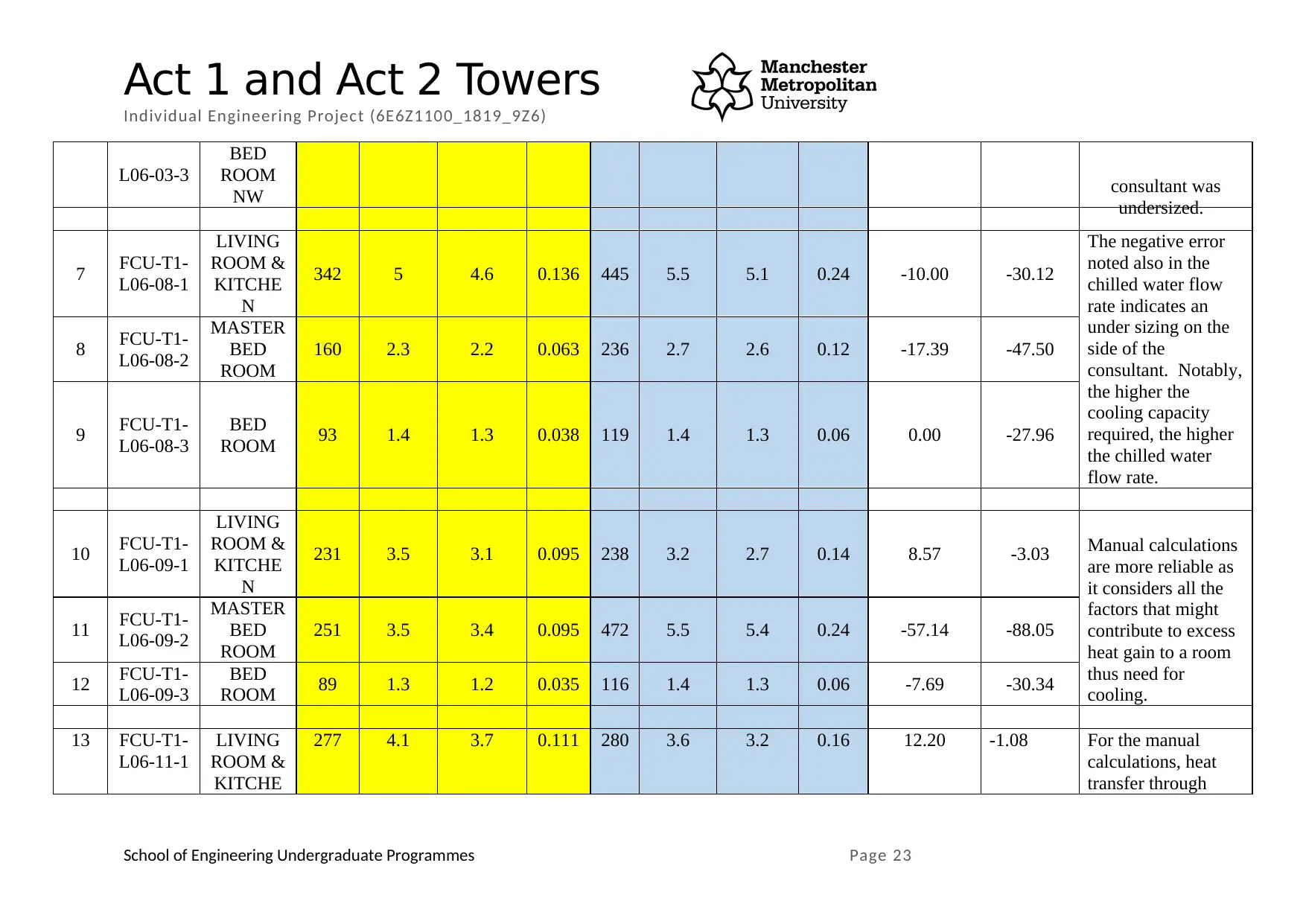
Act 1 and Act 2 Towers
Individual Engineering Project (6E6Z1100_1819_9Z6)
L06-03-3
BED
ROOM
NW consultant was
undersized.
7 FCU-T1-
L06-08-1
LIVING
ROOM &
KITCHE
N
342 5 4.6 0.136 445 5.5 5.1 0.24 -10.00 -30.12
The negative error
noted also in the
chilled water flow
rate indicates an
under sizing on the
side of the
consultant. Notably,
the higher the
cooling capacity
required, the higher
the chilled water
flow rate.
8 FCU-T1-
L06-08-2
MASTER
BED
ROOM
160 2.3 2.2 0.063 236 2.7 2.6 0.12 -17.39 -47.50
9 FCU-T1-
L06-08-3
BED
ROOM 93 1.4 1.3 0.038 119 1.4 1.3 0.06 0.00 -27.96
10 FCU-T1-
L06-09-1
LIVING
ROOM &
KITCHE
N
231 3.5 3.1 0.095 238 3.2 2.7 0.14 8.57 -3.03 Manual calculations
are more reliable as
it considers all the
factors that might
contribute to excess
heat gain to a room
thus need for
cooling.
11 FCU-T1-
L06-09-2
MASTER
BED
ROOM
251 3.5 3.4 0.095 472 5.5 5.4 0.24 -57.14 -88.05
12 FCU-T1-
L06-09-3
BED
ROOM 89 1.3 1.2 0.035 116 1.4 1.3 0.06 -7.69 -30.34
13 FCU-T1-
L06-11-1
LIVING
ROOM &
KITCHE
277 4.1 3.7 0.111 280 3.6 3.2 0.16 12.20 -1.08 For the manual
calculations, heat
transfer through
School of Engineering Undergraduate Programmes Page 23
Individual Engineering Project (6E6Z1100_1819_9Z6)
L06-03-3
BED
ROOM
NW consultant was
undersized.
7 FCU-T1-
L06-08-1
LIVING
ROOM &
KITCHE
N
342 5 4.6 0.136 445 5.5 5.1 0.24 -10.00 -30.12
The negative error
noted also in the
chilled water flow
rate indicates an
under sizing on the
side of the
consultant. Notably,
the higher the
cooling capacity
required, the higher
the chilled water
flow rate.
8 FCU-T1-
L06-08-2
MASTER
BED
ROOM
160 2.3 2.2 0.063 236 2.7 2.6 0.12 -17.39 -47.50
9 FCU-T1-
L06-08-3
BED
ROOM 93 1.4 1.3 0.038 119 1.4 1.3 0.06 0.00 -27.96
10 FCU-T1-
L06-09-1
LIVING
ROOM &
KITCHE
N
231 3.5 3.1 0.095 238 3.2 2.7 0.14 8.57 -3.03 Manual calculations
are more reliable as
it considers all the
factors that might
contribute to excess
heat gain to a room
thus need for
cooling.
11 FCU-T1-
L06-09-2
MASTER
BED
ROOM
251 3.5 3.4 0.095 472 5.5 5.4 0.24 -57.14 -88.05
12 FCU-T1-
L06-09-3
BED
ROOM 89 1.3 1.2 0.035 116 1.4 1.3 0.06 -7.69 -30.34
13 FCU-T1-
L06-11-1
LIVING
ROOM &
KITCHE
277 4.1 3.7 0.111 280 3.6 3.2 0.16 12.20 -1.08 For the manual
calculations, heat
transfer through
School of Engineering Undergraduate Programmes Page 23

Act 1 and Act 2 Towers
Individual Engineering Project (6E6Z1100_1819_9Z6)
N walls, floor, roof,
windows, lighting
and electrical
equipment among
others are
considered.
14 FCU-T1-
L06-11-2
MASTER
BEDROO
M
155 2.2 2.1 0.06 196 2.3 2.2 0.1 -4.55 -26.45
15 FCU-T1-
L06-11-3
BED
ROOM 111 1.6 1.5 0.043 147 1.7 1.7 0.07 -6.25 -32.43
School of Engineering Undergraduate Programmes Page 24
Individual Engineering Project (6E6Z1100_1819_9Z6)
N walls, floor, roof,
windows, lighting
and electrical
equipment among
others are
considered.
14 FCU-T1-
L06-11-2
MASTER
BEDROO
M
155 2.2 2.1 0.06 196 2.3 2.2 0.1 -4.55 -26.45
15 FCU-T1-
L06-11-3
BED
ROOM 111 1.6 1.5 0.043 147 1.7 1.7 0.07 -6.25 -32.43
School of Engineering Undergraduate Programmes Page 24
Paraphrase This Document
Need a fresh take? Get an instant paraphrase of this document with our AI Paraphraser
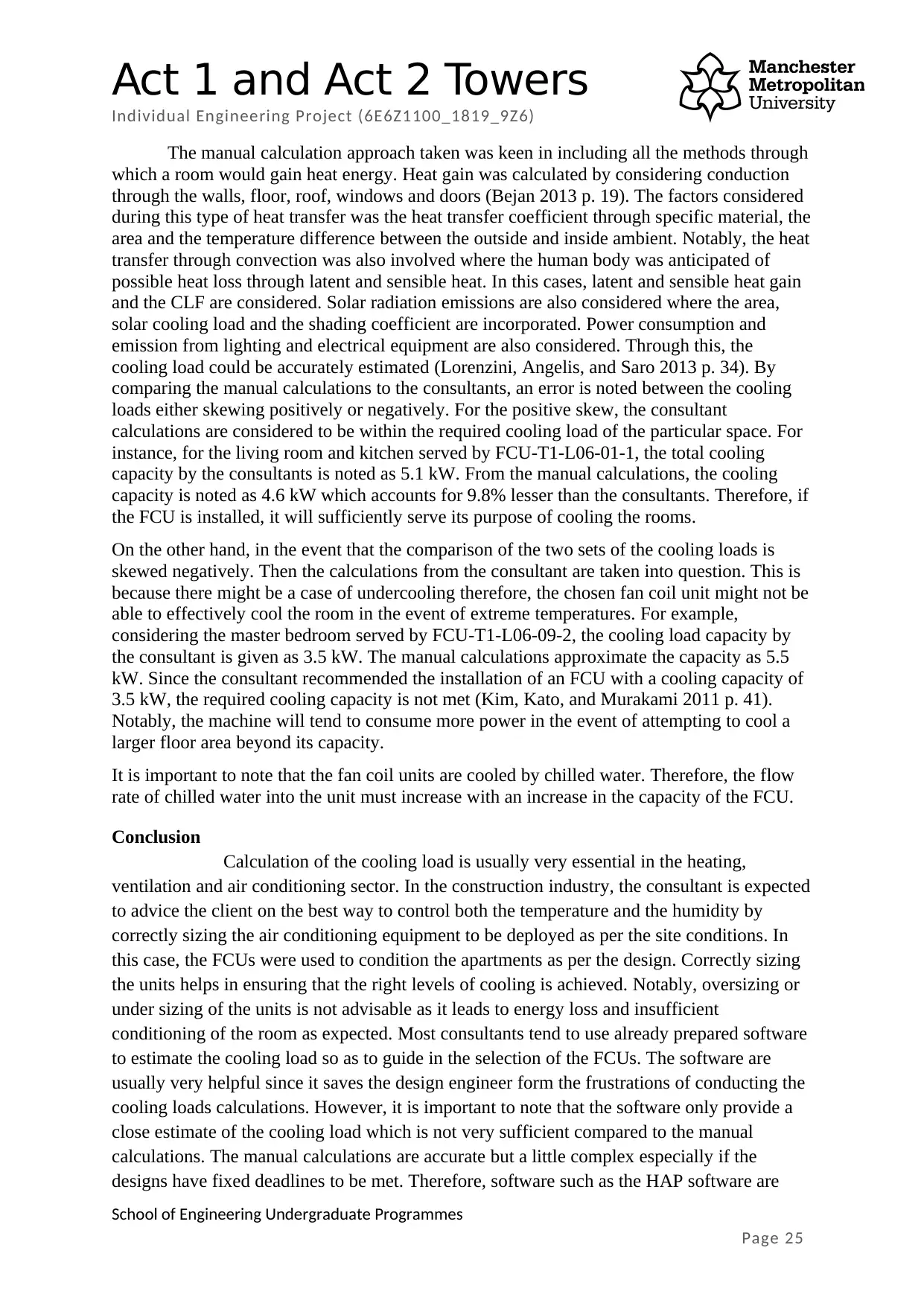
Act 1 and Act 2 Towers
Individual Engineering Project (6E6Z1100_1819_9Z6)
The manual calculation approach taken was keen in including all the methods through
which a room would gain heat energy. Heat gain was calculated by considering conduction
through the walls, floor, roof, windows and doors (Bejan 2013 p. 19). The factors considered
during this type of heat transfer was the heat transfer coefficient through specific material, the
area and the temperature difference between the outside and inside ambient. Notably, the heat
transfer through convection was also involved where the human body was anticipated of
possible heat loss through latent and sensible heat. In this cases, latent and sensible heat gain
and the CLF are considered. Solar radiation emissions are also considered where the area,
solar cooling load and the shading coefficient are incorporated. Power consumption and
emission from lighting and electrical equipment are also considered. Through this, the
cooling load could be accurately estimated (Lorenzini, Angelis, and Saro 2013 p. 34). By
comparing the manual calculations to the consultants, an error is noted between the cooling
loads either skewing positively or negatively. For the positive skew, the consultant
calculations are considered to be within the required cooling load of the particular space. For
instance, for the living room and kitchen served by FCU-T1-L06-01-1, the total cooling
capacity by the consultants is noted as 5.1 kW. From the manual calculations, the cooling
capacity is noted as 4.6 kW which accounts for 9.8% lesser than the consultants. Therefore, if
the FCU is installed, it will sufficiently serve its purpose of cooling the rooms.
On the other hand, in the event that the comparison of the two sets of the cooling loads is
skewed negatively. Then the calculations from the consultant are taken into question. This is
because there might be a case of undercooling therefore, the chosen fan coil unit might not be
able to effectively cool the room in the event of extreme temperatures. For example,
considering the master bedroom served by FCU-T1-L06-09-2, the cooling load capacity by
the consultant is given as 3.5 kW. The manual calculations approximate the capacity as 5.5
kW. Since the consultant recommended the installation of an FCU with a cooling capacity of
3.5 kW, the required cooling capacity is not met (Kim, Kato, and Murakami 2011 p. 41).
Notably, the machine will tend to consume more power in the event of attempting to cool a
larger floor area beyond its capacity.
It is important to note that the fan coil units are cooled by chilled water. Therefore, the flow
rate of chilled water into the unit must increase with an increase in the capacity of the FCU.
Conclusion
Calculation of the cooling load is usually very essential in the heating,
ventilation and air conditioning sector. In the construction industry, the consultant is expected
to advice the client on the best way to control both the temperature and the humidity by
correctly sizing the air conditioning equipment to be deployed as per the site conditions. In
this case, the FCUs were used to condition the apartments as per the design. Correctly sizing
the units helps in ensuring that the right levels of cooling is achieved. Notably, oversizing or
under sizing of the units is not advisable as it leads to energy loss and insufficient
conditioning of the room as expected. Most consultants tend to use already prepared software
to estimate the cooling load so as to guide in the selection of the FCUs. The software are
usually very helpful since it saves the design engineer form the frustrations of conducting the
cooling loads calculations. However, it is important to note that the software only provide a
close estimate of the cooling load which is not very sufficient compared to the manual
calculations. The manual calculations are accurate but a little complex especially if the
designs have fixed deadlines to be met. Therefore, software such as the HAP software are
School of Engineering Undergraduate Programmes
Page 25
Individual Engineering Project (6E6Z1100_1819_9Z6)
The manual calculation approach taken was keen in including all the methods through
which a room would gain heat energy. Heat gain was calculated by considering conduction
through the walls, floor, roof, windows and doors (Bejan 2013 p. 19). The factors considered
during this type of heat transfer was the heat transfer coefficient through specific material, the
area and the temperature difference between the outside and inside ambient. Notably, the heat
transfer through convection was also involved where the human body was anticipated of
possible heat loss through latent and sensible heat. In this cases, latent and sensible heat gain
and the CLF are considered. Solar radiation emissions are also considered where the area,
solar cooling load and the shading coefficient are incorporated. Power consumption and
emission from lighting and electrical equipment are also considered. Through this, the
cooling load could be accurately estimated (Lorenzini, Angelis, and Saro 2013 p. 34). By
comparing the manual calculations to the consultants, an error is noted between the cooling
loads either skewing positively or negatively. For the positive skew, the consultant
calculations are considered to be within the required cooling load of the particular space. For
instance, for the living room and kitchen served by FCU-T1-L06-01-1, the total cooling
capacity by the consultants is noted as 5.1 kW. From the manual calculations, the cooling
capacity is noted as 4.6 kW which accounts for 9.8% lesser than the consultants. Therefore, if
the FCU is installed, it will sufficiently serve its purpose of cooling the rooms.
On the other hand, in the event that the comparison of the two sets of the cooling loads is
skewed negatively. Then the calculations from the consultant are taken into question. This is
because there might be a case of undercooling therefore, the chosen fan coil unit might not be
able to effectively cool the room in the event of extreme temperatures. For example,
considering the master bedroom served by FCU-T1-L06-09-2, the cooling load capacity by
the consultant is given as 3.5 kW. The manual calculations approximate the capacity as 5.5
kW. Since the consultant recommended the installation of an FCU with a cooling capacity of
3.5 kW, the required cooling capacity is not met (Kim, Kato, and Murakami 2011 p. 41).
Notably, the machine will tend to consume more power in the event of attempting to cool a
larger floor area beyond its capacity.
It is important to note that the fan coil units are cooled by chilled water. Therefore, the flow
rate of chilled water into the unit must increase with an increase in the capacity of the FCU.
Conclusion
Calculation of the cooling load is usually very essential in the heating,
ventilation and air conditioning sector. In the construction industry, the consultant is expected
to advice the client on the best way to control both the temperature and the humidity by
correctly sizing the air conditioning equipment to be deployed as per the site conditions. In
this case, the FCUs were used to condition the apartments as per the design. Correctly sizing
the units helps in ensuring that the right levels of cooling is achieved. Notably, oversizing or
under sizing of the units is not advisable as it leads to energy loss and insufficient
conditioning of the room as expected. Most consultants tend to use already prepared software
to estimate the cooling load so as to guide in the selection of the FCUs. The software are
usually very helpful since it saves the design engineer form the frustrations of conducting the
cooling loads calculations. However, it is important to note that the software only provide a
close estimate of the cooling load which is not very sufficient compared to the manual
calculations. The manual calculations are accurate but a little complex especially if the
designs have fixed deadlines to be met. Therefore, software such as the HAP software are
School of Engineering Undergraduate Programmes
Page 25

Act 1 and Act 2 Towers
Individual Engineering Project (6E6Z1100_1819_9Z6)
vital in the HVAC industry as they save designers time for executing the complex
calculations. However, in the event that the design engineer applies cooling load estimation
software, they are expected to back up the capacities with the manual calculations to ensure
that not under sizing or oversizing is experienced.
School of Engineering Undergraduate Programmes
Page 26
Individual Engineering Project (6E6Z1100_1819_9Z6)
vital in the HVAC industry as they save designers time for executing the complex
calculations. However, in the event that the design engineer applies cooling load estimation
software, they are expected to back up the capacities with the manual calculations to ensure
that not under sizing or oversizing is experienced.
School of Engineering Undergraduate Programmes
Page 26
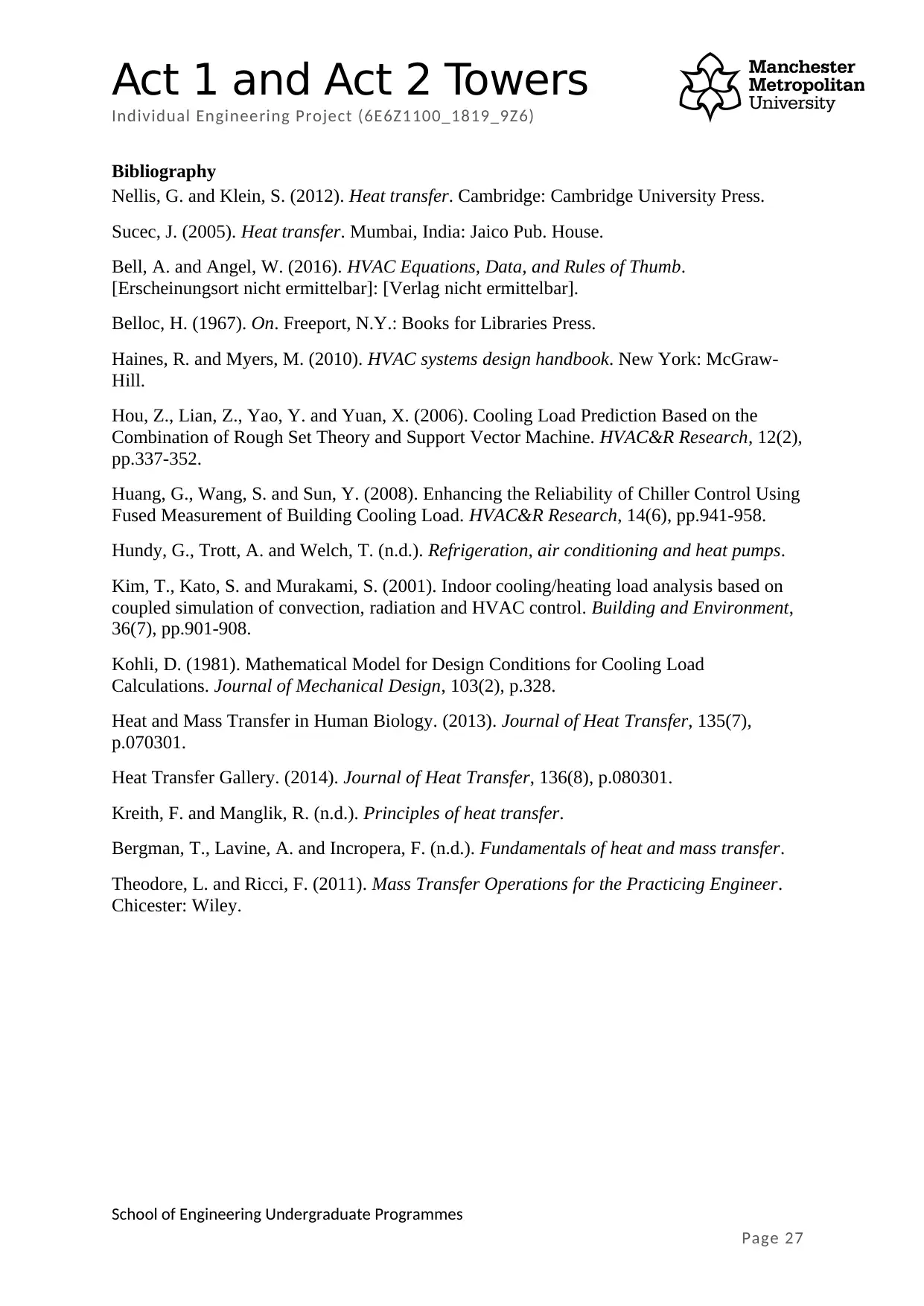
Act 1 and Act 2 Towers
Individual Engineering Project (6E6Z1100_1819_9Z6)
Bibliography
Nellis, G. and Klein, S. (2012). Heat transfer. Cambridge: Cambridge University Press.
Sucec, J. (2005). Heat transfer. Mumbai, India: Jaico Pub. House.
Bell, A. and Angel, W. (2016). HVAC Equations, Data, and Rules of Thumb.
[Erscheinungsort nicht ermittelbar]: [Verlag nicht ermittelbar].
Belloc, H. (1967). On. Freeport, N.Y.: Books for Libraries Press.
Haines, R. and Myers, M. (2010). HVAC systems design handbook. New York: McGraw-
Hill.
Hou, Z., Lian, Z., Yao, Y. and Yuan, X. (2006). Cooling Load Prediction Based on the
Combination of Rough Set Theory and Support Vector Machine. HVAC&R Research, 12(2),
pp.337-352.
Huang, G., Wang, S. and Sun, Y. (2008). Enhancing the Reliability of Chiller Control Using
Fused Measurement of Building Cooling Load. HVAC&R Research, 14(6), pp.941-958.
Hundy, G., Trott, A. and Welch, T. (n.d.). Refrigeration, air conditioning and heat pumps.
Kim, T., Kato, S. and Murakami, S. (2001). Indoor cooling/heating load analysis based on
coupled simulation of convection, radiation and HVAC control. Building and Environment,
36(7), pp.901-908.
Kohli, D. (1981). Mathematical Model for Design Conditions for Cooling Load
Calculations. Journal of Mechanical Design, 103(2), p.328.
Heat and Mass Transfer in Human Biology. (2013). Journal of Heat Transfer, 135(7),
p.070301.
Heat Transfer Gallery. (2014). Journal of Heat Transfer, 136(8), p.080301.
Kreith, F. and Manglik, R. (n.d.). Principles of heat transfer.
Bergman, T., Lavine, A. and Incropera, F. (n.d.). Fundamentals of heat and mass transfer.
Theodore, L. and Ricci, F. (2011). Mass Transfer Operations for the Practicing Engineer.
Chicester: Wiley.
School of Engineering Undergraduate Programmes
Page 27
Individual Engineering Project (6E6Z1100_1819_9Z6)
Bibliography
Nellis, G. and Klein, S. (2012). Heat transfer. Cambridge: Cambridge University Press.
Sucec, J. (2005). Heat transfer. Mumbai, India: Jaico Pub. House.
Bell, A. and Angel, W. (2016). HVAC Equations, Data, and Rules of Thumb.
[Erscheinungsort nicht ermittelbar]: [Verlag nicht ermittelbar].
Belloc, H. (1967). On. Freeport, N.Y.: Books for Libraries Press.
Haines, R. and Myers, M. (2010). HVAC systems design handbook. New York: McGraw-
Hill.
Hou, Z., Lian, Z., Yao, Y. and Yuan, X. (2006). Cooling Load Prediction Based on the
Combination of Rough Set Theory and Support Vector Machine. HVAC&R Research, 12(2),
pp.337-352.
Huang, G., Wang, S. and Sun, Y. (2008). Enhancing the Reliability of Chiller Control Using
Fused Measurement of Building Cooling Load. HVAC&R Research, 14(6), pp.941-958.
Hundy, G., Trott, A. and Welch, T. (n.d.). Refrigeration, air conditioning and heat pumps.
Kim, T., Kato, S. and Murakami, S. (2001). Indoor cooling/heating load analysis based on
coupled simulation of convection, radiation and HVAC control. Building and Environment,
36(7), pp.901-908.
Kohli, D. (1981). Mathematical Model for Design Conditions for Cooling Load
Calculations. Journal of Mechanical Design, 103(2), p.328.
Heat and Mass Transfer in Human Biology. (2013). Journal of Heat Transfer, 135(7),
p.070301.
Heat Transfer Gallery. (2014). Journal of Heat Transfer, 136(8), p.080301.
Kreith, F. and Manglik, R. (n.d.). Principles of heat transfer.
Bergman, T., Lavine, A. and Incropera, F. (n.d.). Fundamentals of heat and mass transfer.
Theodore, L. and Ricci, F. (2011). Mass Transfer Operations for the Practicing Engineer.
Chicester: Wiley.
School of Engineering Undergraduate Programmes
Page 27
Secure Best Marks with AI Grader
Need help grading? Try our AI Grader for instant feedback on your assignments.
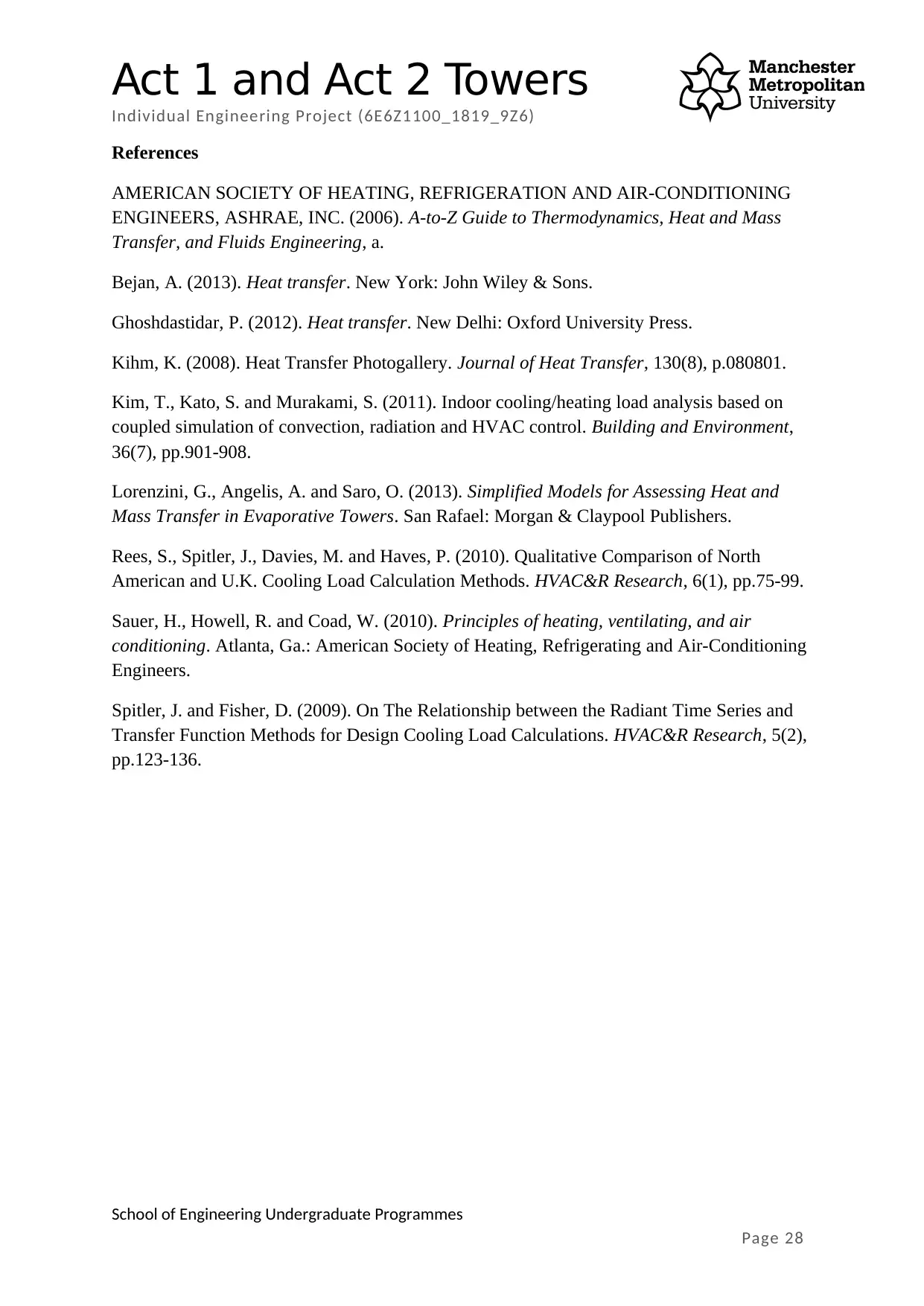
Act 1 and Act 2 Towers
Individual Engineering Project (6E6Z1100_1819_9Z6)
References
AMERICAN SOCIETY OF HEATING, REFRIGERATION AND AIR-CONDITIONING
ENGINEERS, ASHRAE, INC. (2006). A-to-Z Guide to Thermodynamics, Heat and Mass
Transfer, and Fluids Engineering, a.
Bejan, A. (2013). Heat transfer. New York: John Wiley & Sons.
Ghoshdastidar, P. (2012). Heat transfer. New Delhi: Oxford University Press.
Kihm, K. (2008). Heat Transfer Photogallery. Journal of Heat Transfer, 130(8), p.080801.
Kim, T., Kato, S. and Murakami, S. (2011). Indoor cooling/heating load analysis based on
coupled simulation of convection, radiation and HVAC control. Building and Environment,
36(7), pp.901-908.
Lorenzini, G., Angelis, A. and Saro, O. (2013). Simplified Models for Assessing Heat and
Mass Transfer in Evaporative Towers. San Rafael: Morgan & Claypool Publishers.
Rees, S., Spitler, J., Davies, M. and Haves, P. (2010). Qualitative Comparison of North
American and U.K. Cooling Load Calculation Methods. HVAC&R Research, 6(1), pp.75-99.
Sauer, H., Howell, R. and Coad, W. (2010). Principles of heating, ventilating, and air
conditioning. Atlanta, Ga.: American Society of Heating, Refrigerating and Air-Conditioning
Engineers.
Spitler, J. and Fisher, D. (2009). On The Relationship between the Radiant Time Series and
Transfer Function Methods for Design Cooling Load Calculations. HVAC&R Research, 5(2),
pp.123-136.
School of Engineering Undergraduate Programmes
Page 28
Individual Engineering Project (6E6Z1100_1819_9Z6)
References
AMERICAN SOCIETY OF HEATING, REFRIGERATION AND AIR-CONDITIONING
ENGINEERS, ASHRAE, INC. (2006). A-to-Z Guide to Thermodynamics, Heat and Mass
Transfer, and Fluids Engineering, a.
Bejan, A. (2013). Heat transfer. New York: John Wiley & Sons.
Ghoshdastidar, P. (2012). Heat transfer. New Delhi: Oxford University Press.
Kihm, K. (2008). Heat Transfer Photogallery. Journal of Heat Transfer, 130(8), p.080801.
Kim, T., Kato, S. and Murakami, S. (2011). Indoor cooling/heating load analysis based on
coupled simulation of convection, radiation and HVAC control. Building and Environment,
36(7), pp.901-908.
Lorenzini, G., Angelis, A. and Saro, O. (2013). Simplified Models for Assessing Heat and
Mass Transfer in Evaporative Towers. San Rafael: Morgan & Claypool Publishers.
Rees, S., Spitler, J., Davies, M. and Haves, P. (2010). Qualitative Comparison of North
American and U.K. Cooling Load Calculation Methods. HVAC&R Research, 6(1), pp.75-99.
Sauer, H., Howell, R. and Coad, W. (2010). Principles of heating, ventilating, and air
conditioning. Atlanta, Ga.: American Society of Heating, Refrigerating and Air-Conditioning
Engineers.
Spitler, J. and Fisher, D. (2009). On The Relationship between the Radiant Time Series and
Transfer Function Methods for Design Cooling Load Calculations. HVAC&R Research, 5(2),
pp.123-136.
School of Engineering Undergraduate Programmes
Page 28
1 out of 29
Your All-in-One AI-Powered Toolkit for Academic Success.
+13062052269
info@desklib.com
Available 24*7 on WhatsApp / Email
![[object Object]](/_next/static/media/star-bottom.7253800d.svg)
Unlock your academic potential
© 2024 | Zucol Services PVT LTD | All rights reserved.